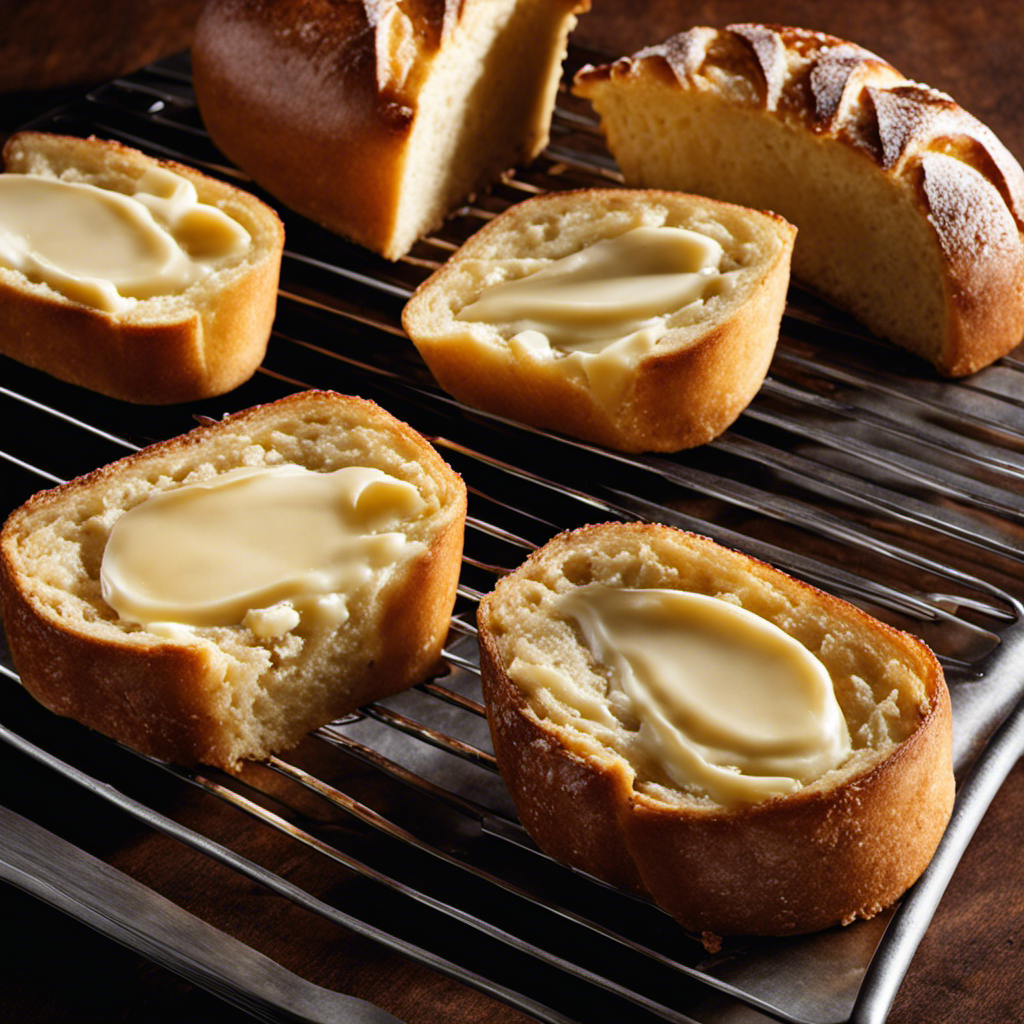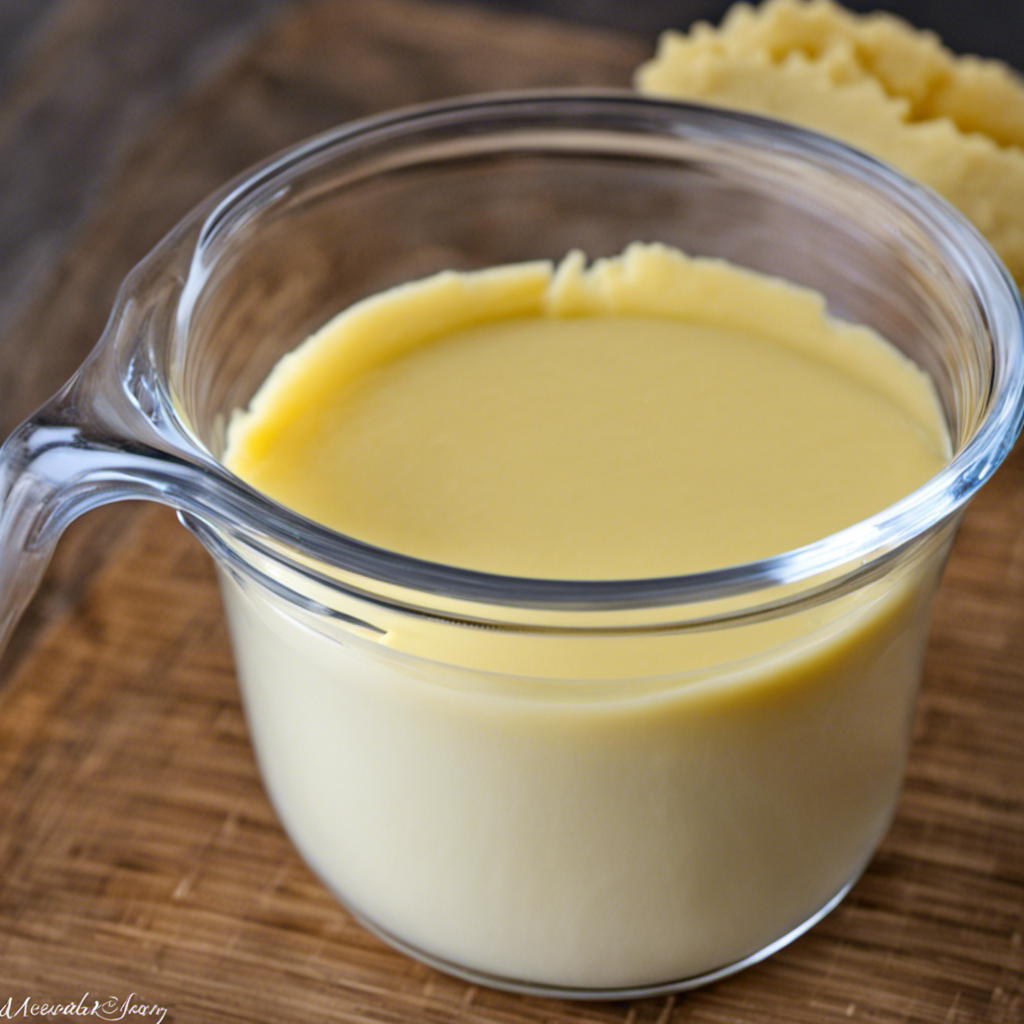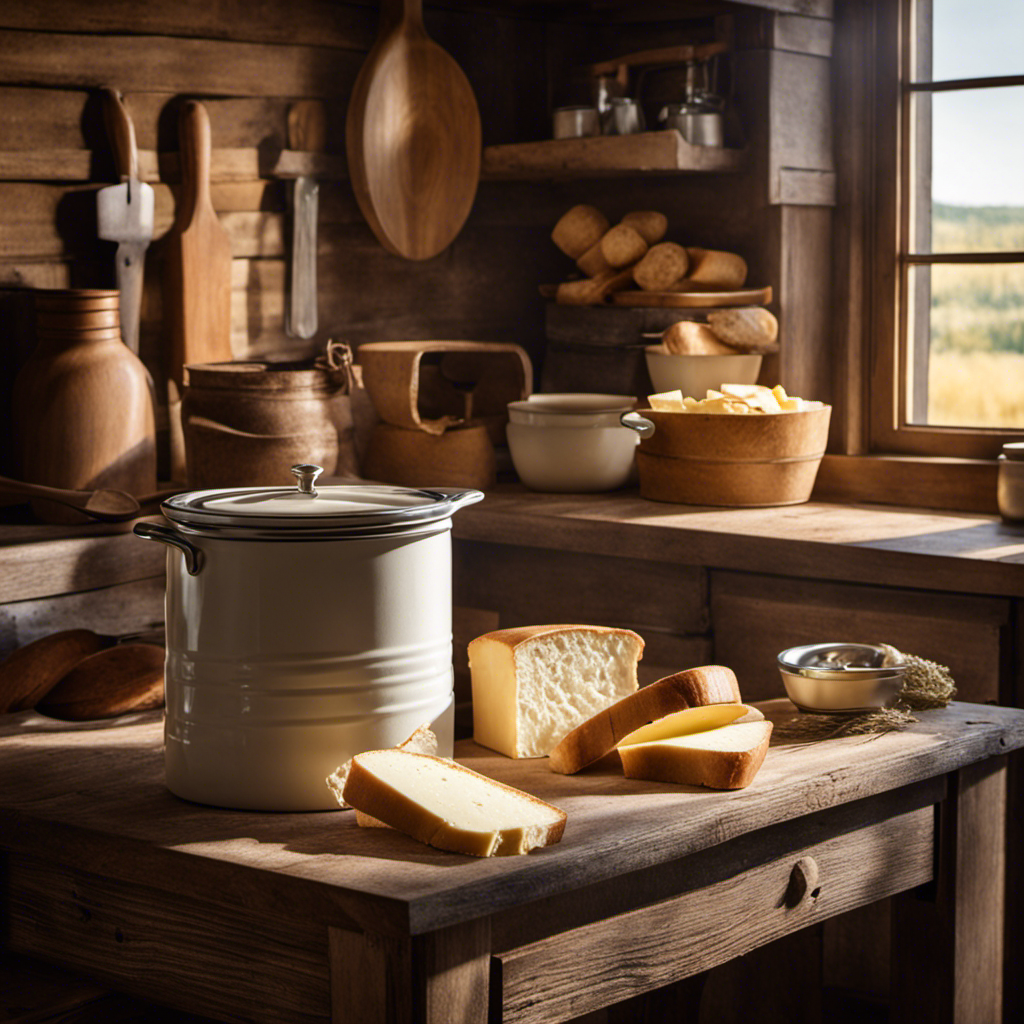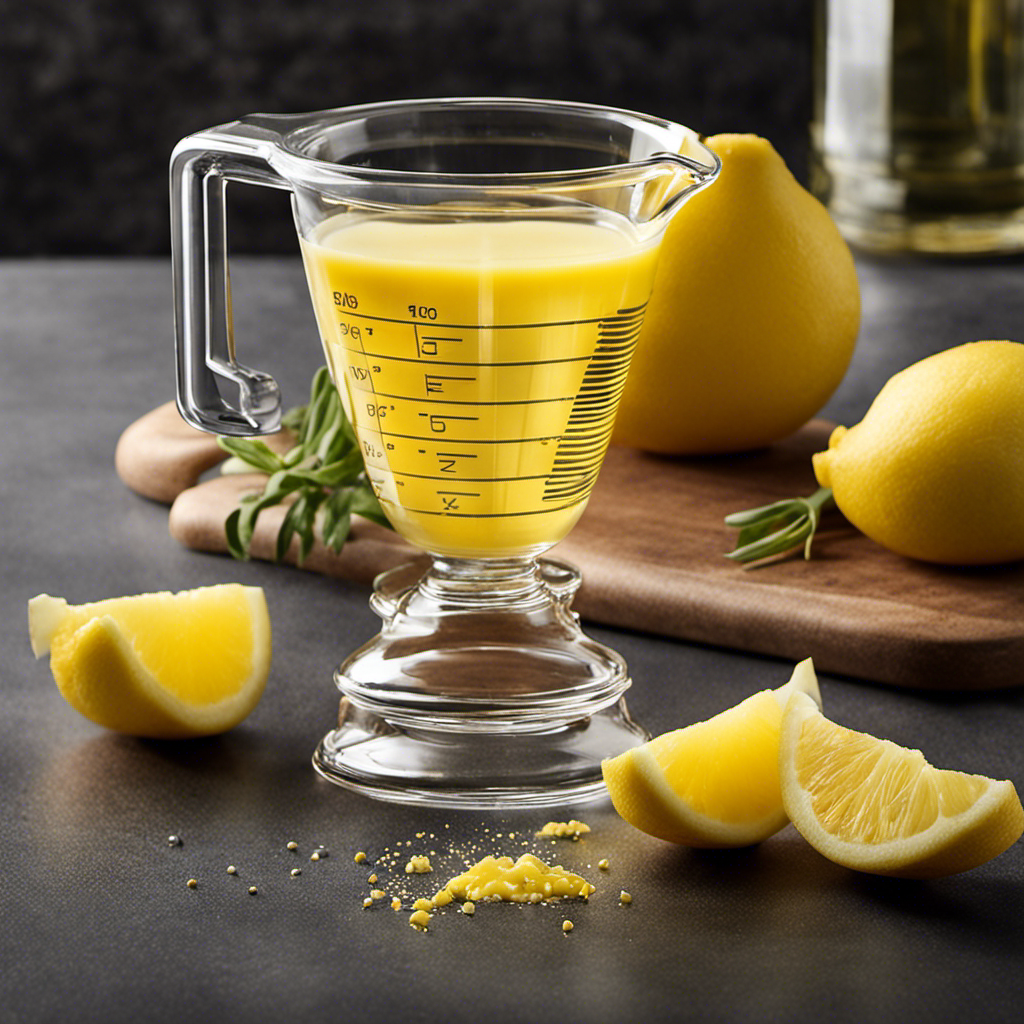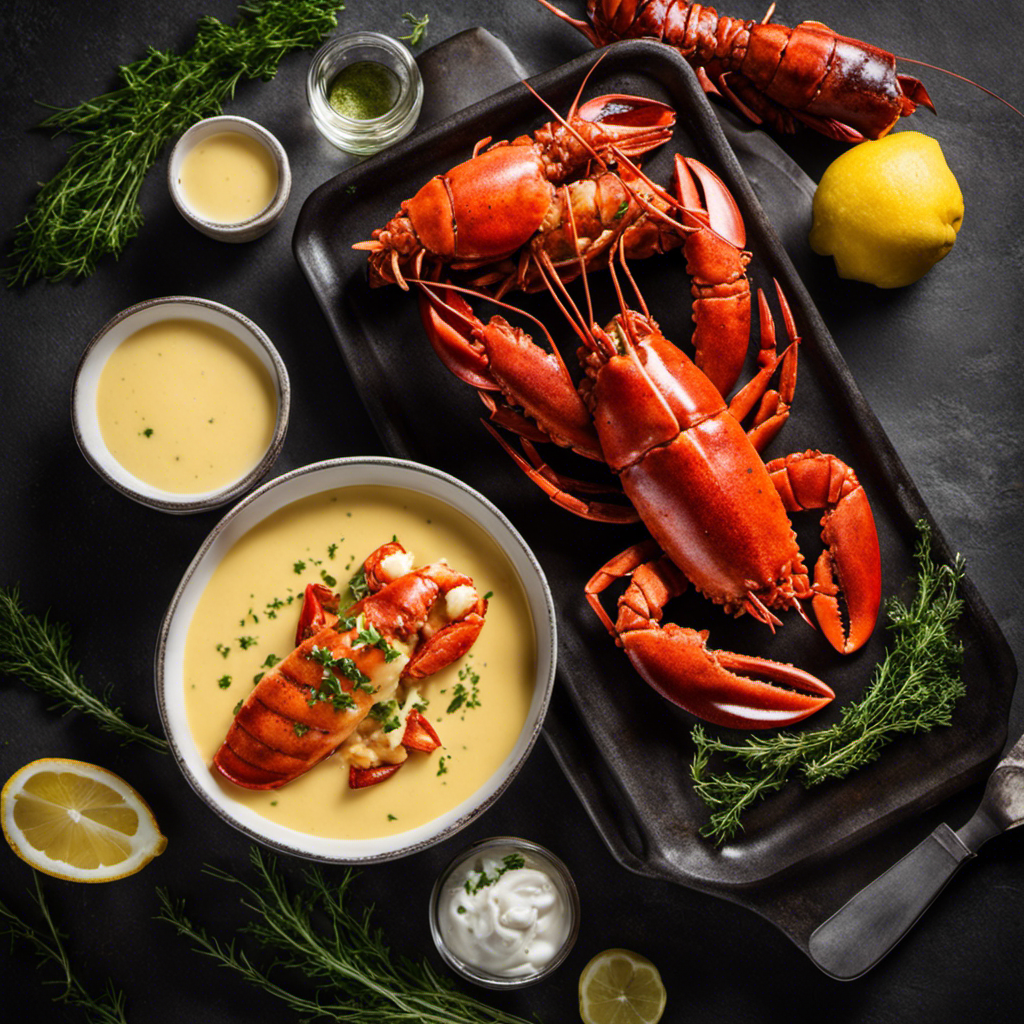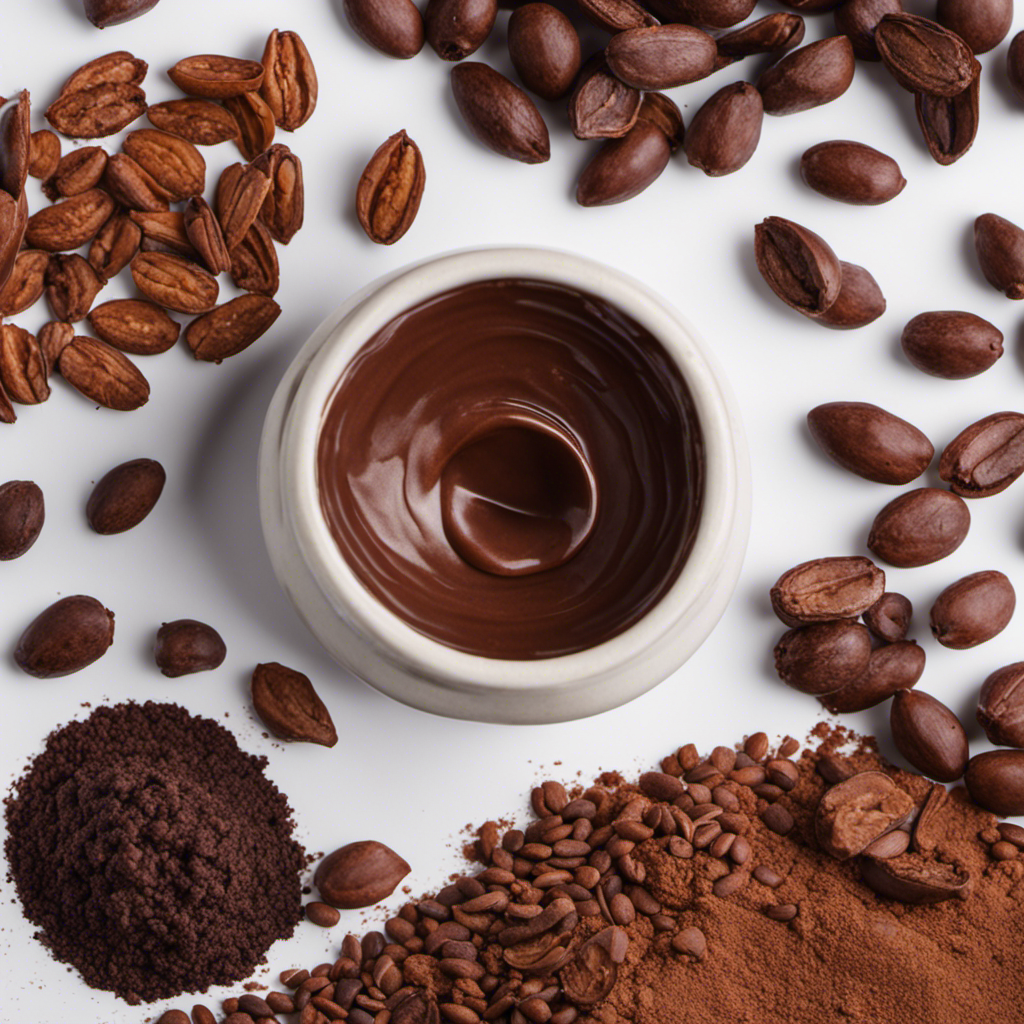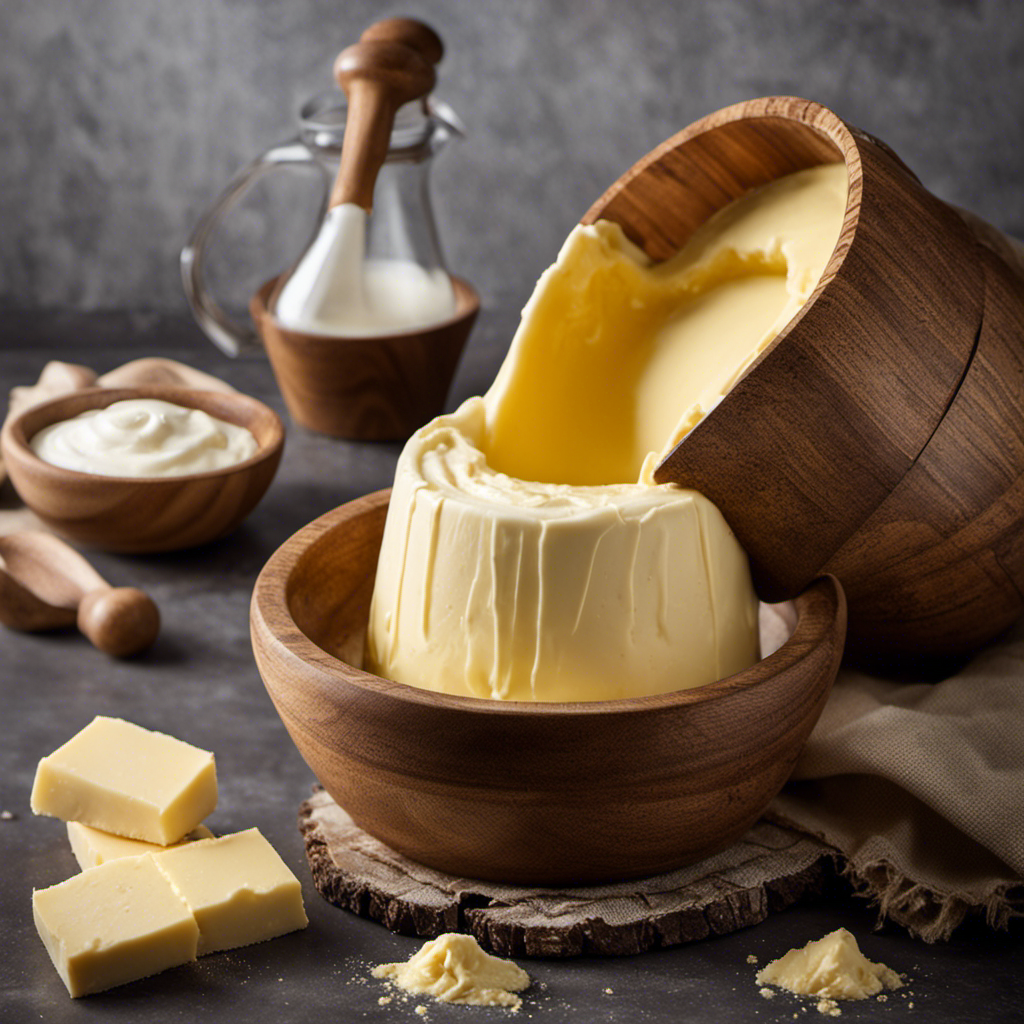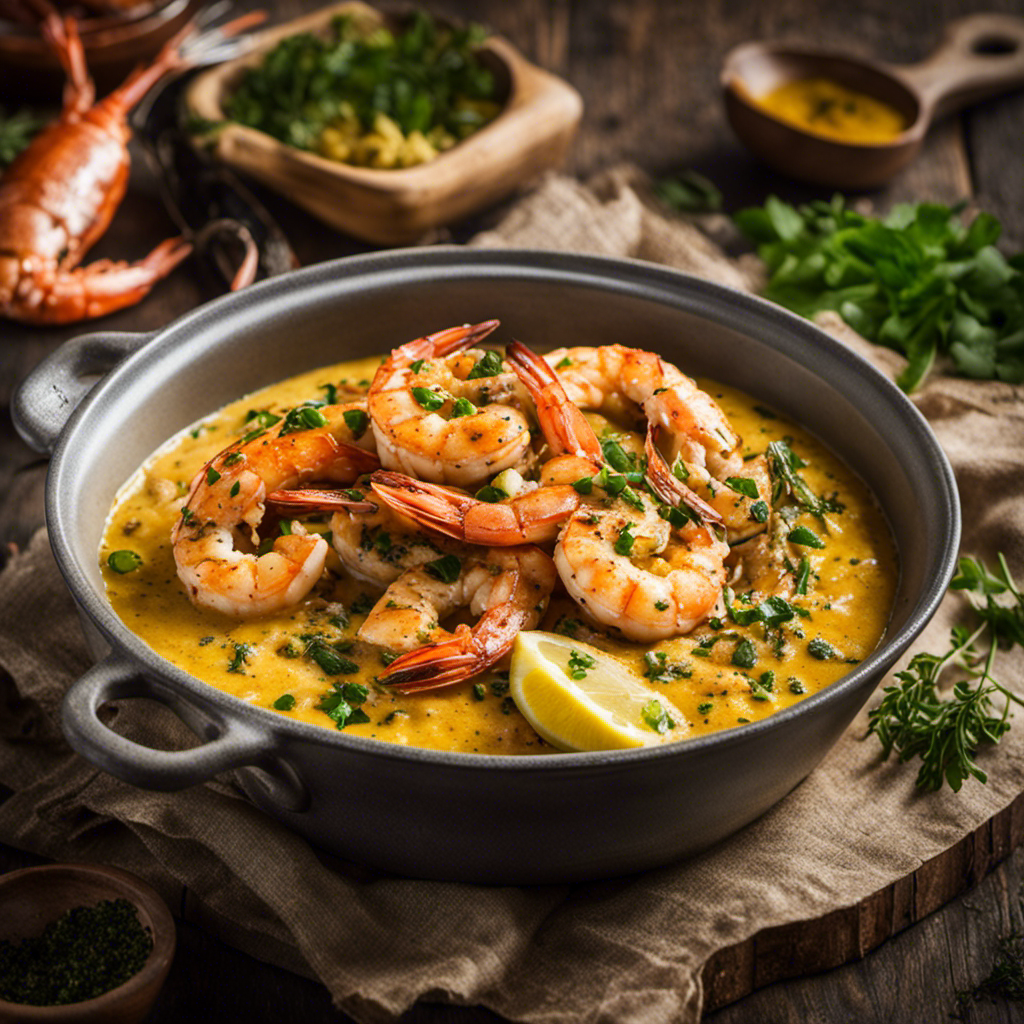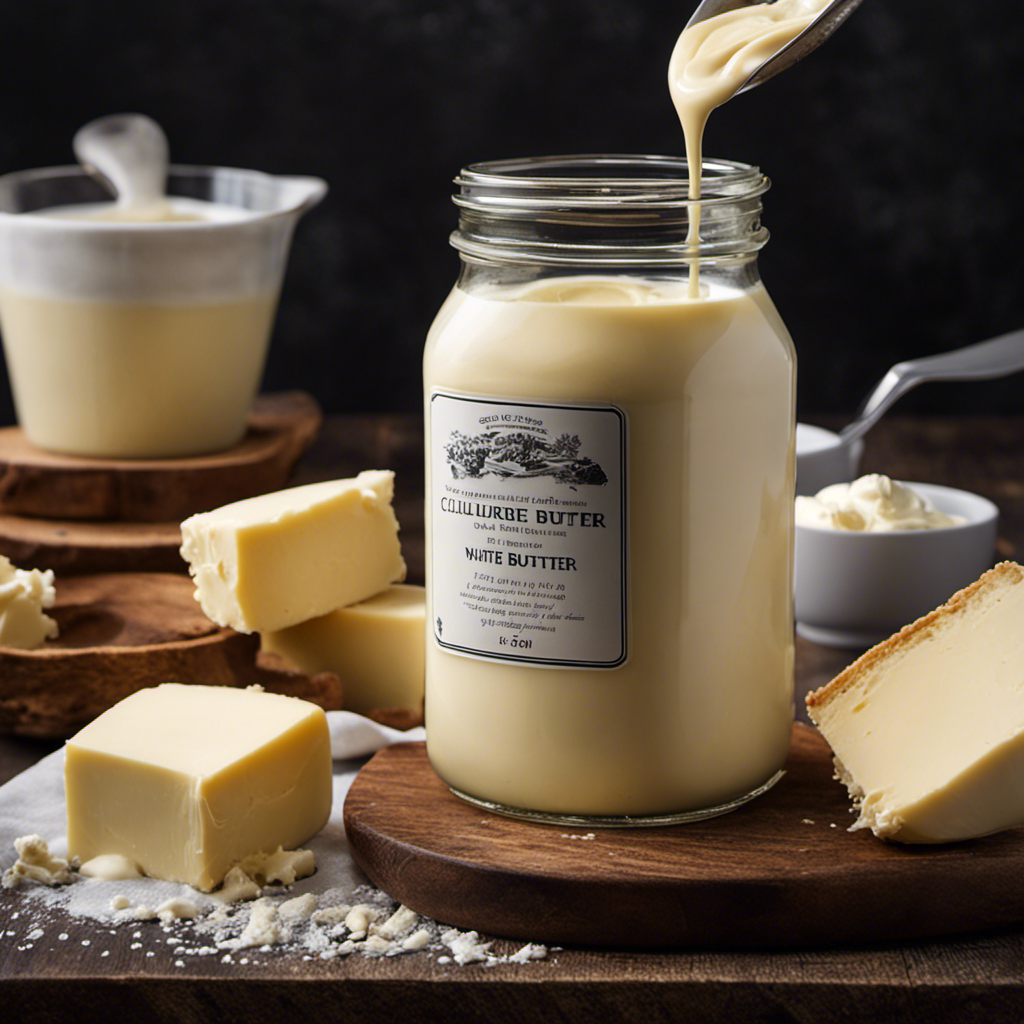Peanut Butter
What Makes Peanut Butter Non-Perishable?

Pondering the peculiar perseverance of peanut butter, we find ourselves intrigued by its non-perishable nature. Have you ever wondered why this creamy spread seems to defy the passage of time?
The answer lies in its unique composition and the processes used to create it. Join us as we unravel the mystery behind this beloved pantry staple and uncover the factors that render it impervious to spoilage.
Key Takeaways
- The low moisture content and high oil content of peanut butter inhibit bacterial growth and prevent spoilage.
- Proper packaging techniques, such as vacuum sealing and aseptic packaging, help extend the shelf life of peanut butter.
- Peanut butter's stability is due to its high fat content and low water activity, which preserve its nutrient composition.
- Microbial control methods and oxygen barrier packaging are essential for maintaining the quality and freshness of peanut butter.
Peanut Butter Preservation: An Overview
When considering the preservation of peanut butter, its low moisture content and high oil content play a significant role in inhibiting bacterial growth, making it a non-perishable food item. The absence of water prevents the growth of microorganisms, while the high oil content acts as a barrier to bacterial proliferation. This unique composition gives peanut butter an extended shelf life, making it suitable for long-term storage without the need for refrigeration. However, it's essential to note that storing peanut butter in the refrigerator can further prolong its shelf life and prevent the oil from turning rancid.
Sealed jars of commercially produced peanut butter can be conveniently stored in the pantry, but for optimal preservation, refrigeration can be beneficial. Natural or preservative-free peanut butter, in particular, may benefit from refrigeration to maintain freshness for a longer period. In hot and humid climates, refrigerating peanut butter for long-term storage is advisable to prevent oil separation and maintain its quality.
Nevertheless, it's important to emphasize that refrigeration isn't necessary for immediate consumption, as peanut butter remains safe at room temperature for extended periods.
The Role of Ingredients
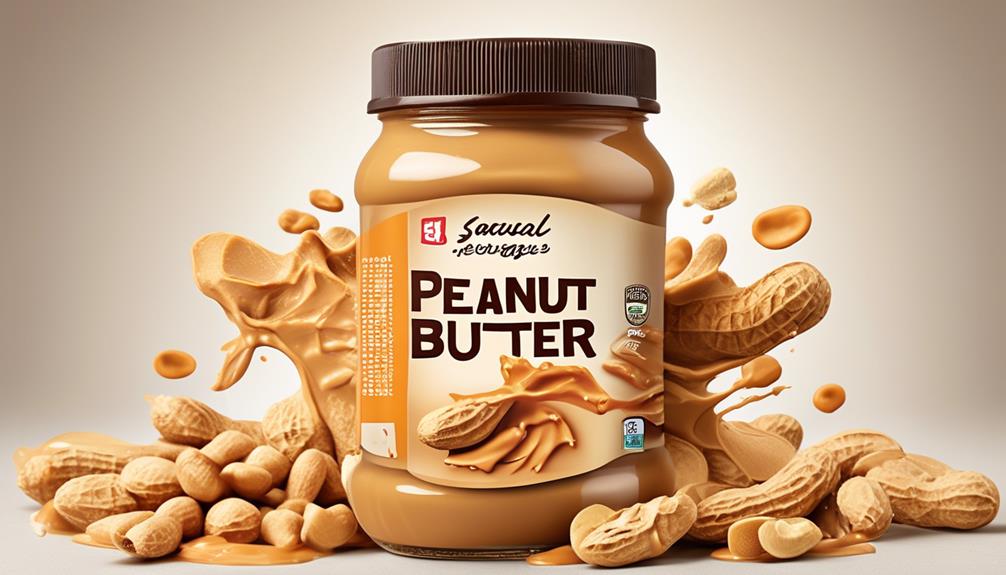
The unique composition of peanut butter, characterized by its natural oils and low moisture content, significantly contributes to its resistance to bacterial growth and spoilage, laying the foundation for understanding the role of ingredients in its preservation.
When we delve into the role of ingredients in peanut butter preservation, we uncover the following insights:
- Natural Oils: The natural oils present in peanut butter act as a protective barrier against the growth of bacteria and other microorganisms. These oils create an environment that's inhospitable to microbial activity, thereby enhancing the shelf life of peanut butter.
- Sub-point: Unsaturated fats, such as those found in peanut butter, have been shown to possess antimicrobial properties, further bolstering its resistance to spoilage.
- Low Moisture Content: With its inherently low moisture content, peanut butter limits the availability of water that's crucial for microbial proliferation. This scarcity of moisture impedes the growth of bacteria, mold, and yeast, thereby contributing to the non-perishable nature of peanut butter.
- Sub-point: The absence of free water in peanut butter inhibits the enzymatic and chemical reactions that lead to spoilage, thereby extending its shelf life.
Understanding the pivotal role played by these ingredients underscores the remarkable non-perishable attribute of natural peanut butter.
Processing Methods

Utilizing various processing methods is essential for preserving the quality and safety of peanut butter. When it comes to peanut butter, processing methods play a critical role in ensuring its long shelf life and non-perishable nature.
One common method is pasteurization, which involves heating the peanut butter to a specific temperature for a set period to eliminate harmful bacteria and enzymes. This process not only extends the product's shelf life but also maintains its overall quality.
Additionally, the use of airtight packaging, such as vacuum sealing, prevents the entry of oxygen, which can cause rancidity in the peanut butter. Furthermore, manufacturers often employ advanced emulsification techniques to create a stable and homogenous product that resists separation of oil and solids, contributing to its non-perishable characteristics.
These meticulous processing methods, combined with strict quality control measures, ensure that peanut butter remains safe for consumption over an extended period. By carefully selecting and implementing these processing methods, the peanut butter industry can deliver a product that meets consumer expectations for both safety and quality.
Packaging Techniques
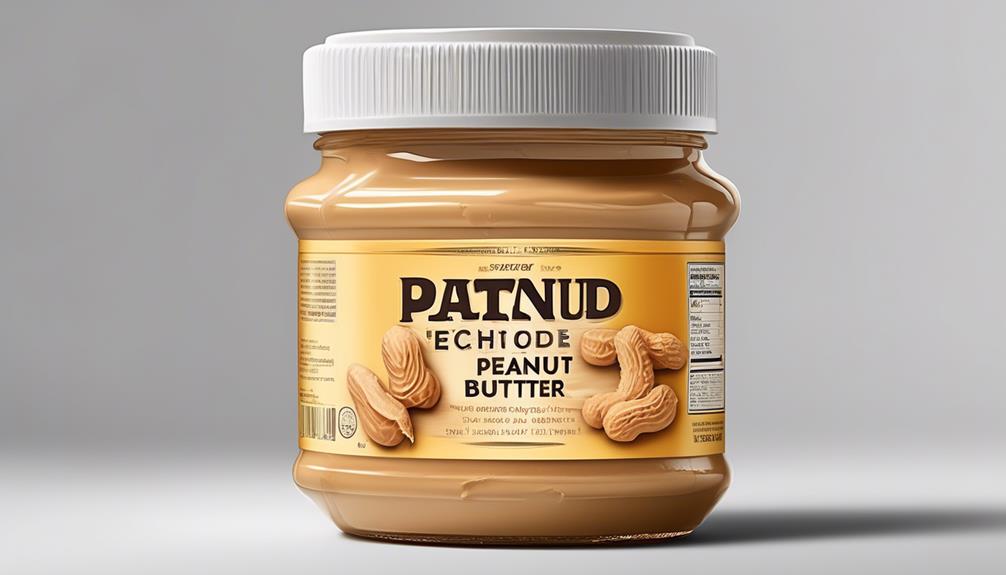
To ensure the longevity and quality of peanut butter, employing advanced packaging techniques is crucial for extending its shelf life and preserving its freshness. When it comes to achieving long shelf life for peanut butter, packaging plays a vital role.
Here are the advanced packaging techniques that contribute to the non-perishable nature of canned peanut butter:
- Vacuum sealing and modified atmosphere packaging:
These methods involve removing air from the packaging or altering the atmosphere within it to slow down the spoilage process and preserve the product's freshness. By minimizing exposure to oxygen, the degradation of the peanut butter is significantly reduced, ensuring a longer shelf life.
- Aseptic and retort packaging:
Aseptic packaging involves sterilizing the product and packaging separately, then filling the sterile product into the sterile package in a controlled environment to prevent recontamination. On the other hand, retort packaging subjects the packaged food to high heat and pressure to sterilize it, ensuring long-term preservation without refrigeration. These techniques contribute to the long shelf life of canned peanut butter by maintaining its sterility and quality over time.
In essence, the combination of these packaging techniques contributes to the non-perishable nature of peanut butter, ensuring that it remains fresh and safe for consumption over an extended period.
Eliminating Moisture
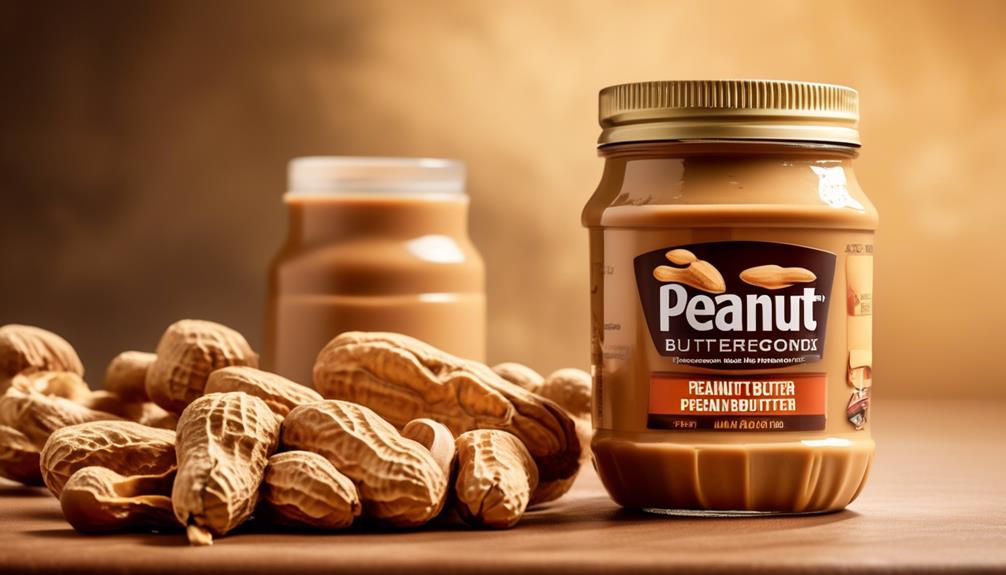
After exploring advanced packaging techniques to ensure the non-perishable nature of canned peanut butter, the next crucial aspect to consider is the effective elimination of moisture from the product. Moisture is a critical factor in the spoilage of peanut butter, as it provides an environment conducive to bacterial growth and mold formation. By reducing the moisture content in peanut butter, the potential for spoilage is significantly diminished, thereby extending its shelf life. Proper sealing and storage play a vital role in eliminating moisture and maintaining the freshness of peanut butter. This process is essential for increasing the shelf stability of non-perishable foods like peanut butter.
The elimination of moisture in peanut butter isn't only instrumental in preventing spoilage but also in reducing the risk of rancidity. When moisture is present, it can lead to the oxidation of the natural oils in peanut butter, resulting in a stale or off-flavor. Therefore, meticulous attention to moisture control is imperative in the production and storage of peanut butter to ensure its non-perishable nature.
Nutrient Composition
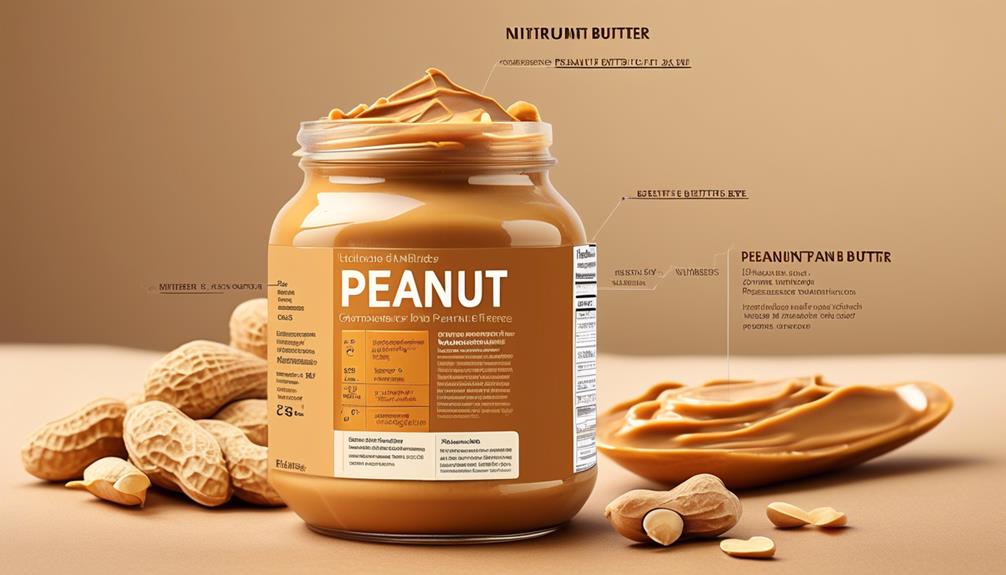
The nutrient composition of peanut butter is crucial to its overall nutritional value. We need to analyze the stable fat content, low water activity, and high acid level to understand its impact on health and dietary requirements.
Stable Fat Content
With its stable fat content, peanut butter serves as a reliable non-perishable food item due to its ability to inhibit spoilage and rancidity, as well as providing essential fatty acids and energy.
The stable fat content in peanut butter plays a crucial role in its non-perishable nature and long shelf life. This stability is attributed to the high fat content acting as a natural preservative, inhibiting the growth of bacteria and mold.
Additionally, the nutrient composition of peanut butter, including its stable fat content, makes it a valuable source of energy and essential fatty acids for consumers. The stable fat content also makes peanut butter a convenient and versatile non-perishable ingredient for various recipes and meal options, contributing to its widespread popularity and use in households.
Moreover, the stable fat content in peanut butter shares similarities with other non-perishable items like shelf-stable milk, enhancing its role as a staple pantry item.
Low Water Activity
Peanut butter's stability due to its high fat content makes it an ideal candidate for discussing the nutrient composition of low water activity foods, emphasizing their resistance to spoilage and microbial growth.
In the case of peanut butter, its low water activity plays a crucial role in preserving its nutrient composition. With minimal moisture content, peanut butter becomes inhospitable to spoilage and microbial growth, ensuring the stability of its nutrient composition over time.
The limited availability of water for chemical reactions in low water activity foods like peanut butter helps in preserving the essential nutrients present in the product. This makes peanut butter and other low water activity foods an excellent choice for long-term storage while maintaining their nutritional quality.
Understanding the impact of low water activity on the nutrient composition of peanut butter enhances our appreciation of its non-perishable nature.
High Acid Level
In examining the nutrient composition of peanut butter, the high acid level, characterized by the presence of various organic acids such as oleic acid, linoleic acid, and palmitic acid, significantly contributes to its unique flavor profile and acts as a natural preservative, enhancing its shelf stability.
The high acid level in peanut butter plays a crucial role in its non-perishable nature, primarily due to its ability to inhibit the growth of certain bacteria and molds. Additionally, this nutrient composition extends the shelf life of peanut butter, making it a reliable source of healthy fats, protein, and essential nutrients over an extended period.
This unique attribute not only ensures the longevity of peanut butter but also enhances its distinct taste and texture, solidifying its position as a popular and versatile pantry staple.
Ph Levels and Acidity
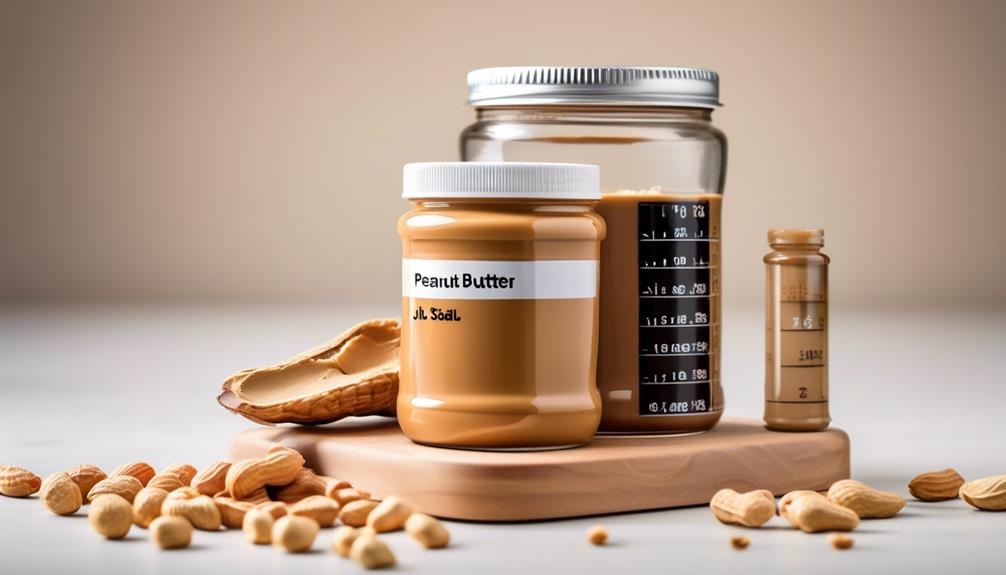
The acidity of peanut butter, as indicated by its pH levels, plays a crucial role in determining its shelf stability as a non-perishable food product. Peanut butter typically has a pH level ranging from 6.5 to 7.5, making it slightly acidic. This level of acidity is essential for preventing the growth of harmful bacteria, molds, and yeasts, which could otherwise spoil the product. The pH levels in peanut butter create an environment where microorganisms struggle to survive, thus prolonging its shelf life.
| pH Level | Description | Effect on Shelf Life |
|---|---|---|
| < 6.5 | More acidic | Longer shelf life |
| 6.5-7.5 | Slightly acidic | Optimal for storage |
| > 7.5 | Less acidic | Shorter shelf life |
Maintaining the optimal pH levels is crucial in preventing the rancidity of the unsaturated fats in peanut butter. When the pH levels are too high, the fats can oxidize more rapidly, leading to off-flavors and a shorter shelf life. Therefore, the acidity of peanut butter, as determined by its pH levels, is a key factor in ensuring that it remains a safe and non-perishable food product.
Microbial Control

With the goal of managing and reducing the presence of microorganisms in a specific environment or product, microbial control encompasses various methods such as sterilization, disinfection, and sanitation to prevent the growth and spread of harmful bacteria, viruses, fungi, and other microorganisms. In the context of peanut butter production, microbial control plays a critical role in ensuring the product's safety and longevity.
Importance of Shelf Life:
Effective microbial control measures are essential for extending the shelf life of peanut butter. By minimizing the presence of microorganisms, the risk of spoilage and degradation of the product is significantly reduced, ultimately prolonging its shelf life and enhancing consumer satisfaction.
Ensuring Product Safety:
Microbial control is imperative for guaranteeing the safety of peanut butter. It helps in preventing the growth of harmful pathogens that could potentially cause foodborne illnesses. Through rigorous control measures, the risk of contamination is mitigated, ensuring that consumers can confidently enjoy the product without concerns about microbial-related health hazards.
Implementing stringent microbial control measures is crucial for maintaining the quality, safety, and longevity of peanut butter, ultimately contributing to its non-perishable nature and consumer satisfaction.
Oxygen Exposure
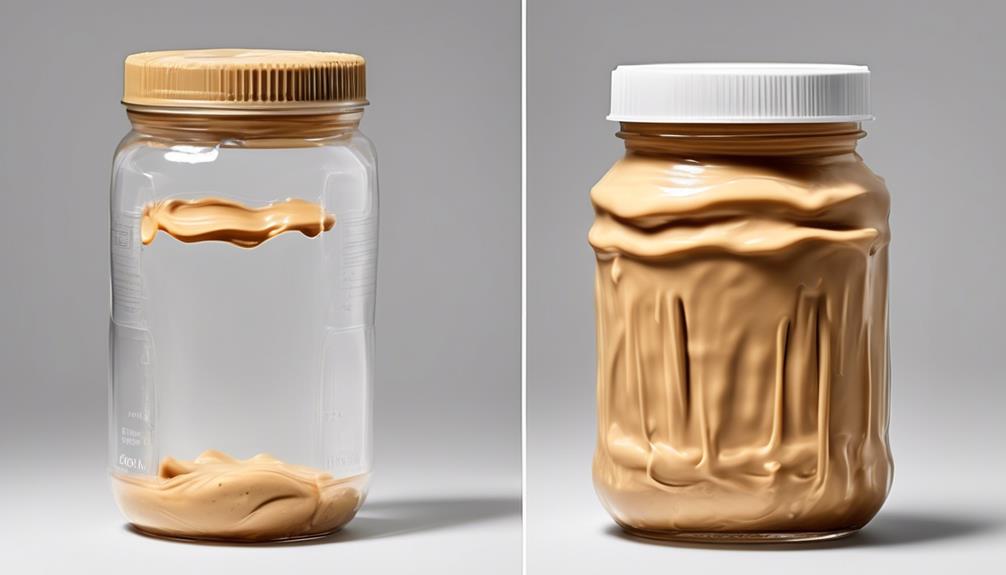
Pivoting from our discussion of microbial control, our focus now turns to the impact of oxygen exposure on the quality and longevity of food products, particularly in the context of peanut butter production. Oxygen exposure poses a significant threat to the shelf life and overall quality of peanut butter.
When peanut butter is exposed to oxygen, it can undergo oxidation, leading to rancidity and a decline in sensory attributes. This oxidation process can cause the fats in peanut butter to break down, resulting in off-flavors and a shorter shelf life.
To mitigate the effects of oxygen exposure, peanut butter manufacturers often utilize oxygen barrier packaging and storage methods that limit the amount of oxygen in contact with the product. Vacuum sealing and the use of oxygen absorbers are effective strategies to reduce oxygen exposure and prolong the freshness of peanut butter.
By minimizing oxygen exposure, these methods help to maintain the product's quality and ensure that it stays fresh for an extended period.
In addition to impacting shelf life, oxygen exposure can also affect the color, flavor, and nutritional value of peanut butter over time, making it crucial to implement effective measures to control oxygen exposure throughout the production and storage processes.
Shelf Stability
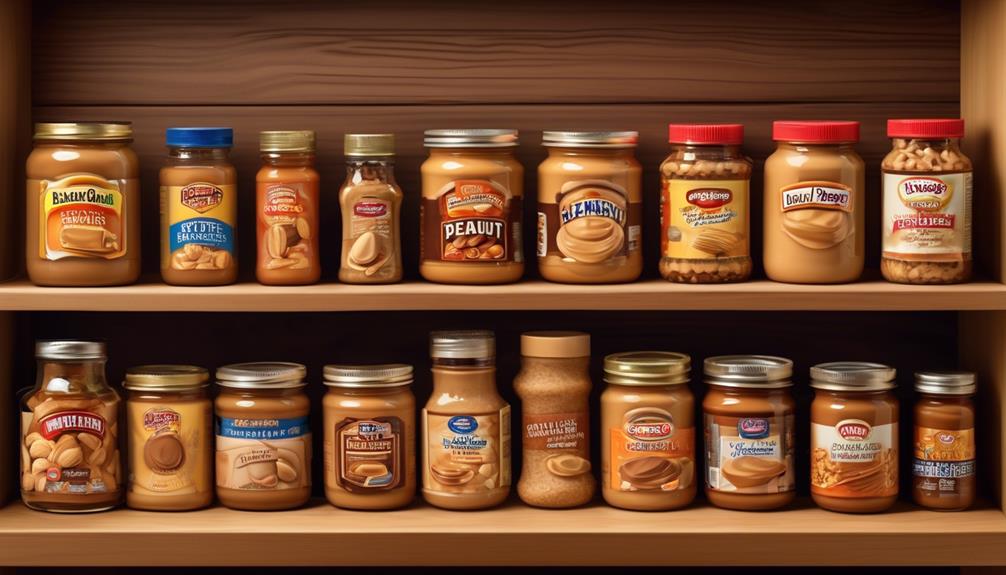
Preservatives play a crucial role in extending the shelf life of non-perishable foods like peanut butter. The low water content and natural oil barrier of peanut butter contribute to its resistance to spoilage.
Understanding the impact of these factors on shelf stability is essential for ensuring the longevity of this pantry staple.
Preservatives for Longevity
Utilizing a combination of antioxidants, antimicrobials, and acidulants, food manufacturers extend the shelf life of non-perishable products, ensuring their longevity and preserving quality for extended storage and distribution.
These preservatives work synergistically to inhibit the growth of bacteria, mold, and yeast, thereby preventing spoilage and maintaining the freshness of products like peanut butter.
Additionally, the inclusion of antioxidants helps to prevent the oxidation of fats and oils in peanut butter, preserving its flavor and nutritional value over time.
Low Water Content
Foods with low water content, such as peanut butter, exhibit extended shelf stability due to their reduced moisture levels, which inhibit microbial growth. This reduced water activity makes peanut butter less prone to spoilage, as bacteria and mold require moisture to thrive.
The absence of moisture in low water content foods like peanut butter contributes to their long shelf life and non-perishable nature. Additionally, products with low water content, like peanut butter, are less susceptible to enzymatic and chemical reactions that cause spoilage, further contributing to their extended shelf stability.
The low water content in peanut butter makes it less likely to support the growth of microorganisms, making it suitable for long-term storage without refrigeration. This characteristic is crucial in ensuring the longevity and safety of peanut butter for consumption.
Natural Oil Barrier
Creating a natural oil barrier is a crucial technique utilized to enhance the shelf stability of certain food products, including peanut butter, by inhibiting microbial growth and preventing fat oxidation.
This barrier is achieved by reducing the water activity in the food and controlling pH levels. Additionally, the use of antioxidants to prevent rancidity plays a vital role in creating this protective barrier.
By creating an environment inhospitable to microorganisms and stabilizing the fats, natural oil barrier helps extend the shelf life of products without the need for refrigeration.
Foods with natural oil barriers, such as peanut butter, maintain their quality and safety without the need for preservatives, offering convenience and long-term storage options.
This method ensures that peanut butter remains safe and palatable over an extended period, making it suitable for storage at room temperature.
Natural Antioxidants
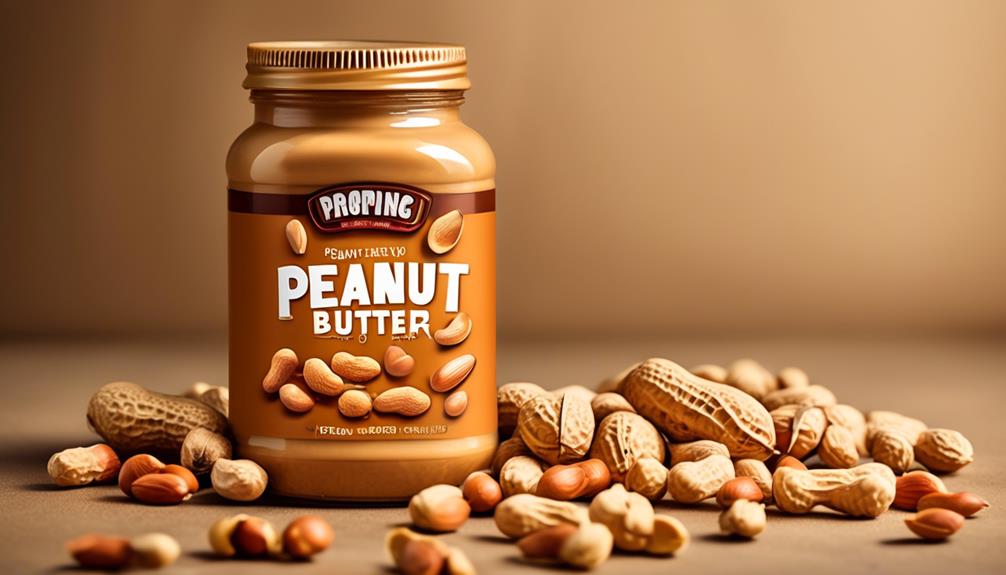
Incorporating natural antioxidants into one's diet is essential for protecting the body from damage caused by free radicals. These substances, abundant in various fruits, vegetables, nuts, seeds, and whole grains, play a crucial role in extending the shelf life of products like peanut butter.
Peanut butter, rich in natural oils, is prone to oxidation, resulting in rancidity and spoilage. However, the inclusion of natural antioxidants such as vitamin E, found in nuts and seeds, can mitigate this process.
Vitamin E, specifically in the form of alpha-tocopherol, acts as a potent antioxidant, effectively delaying the oxidation of the unsaturated fats present in peanut butter. This not only prevents the development of off-flavors but also extends its shelf life.
Additionally, peanut butter contains other natural antioxidants such as p-coumaric acid, a compound known for its free radical-scavenging properties. By harnessing the power of these natural antioxidants, the stability and longevity of peanut butter can be significantly enhanced, ensuring its non-perishable nature and preserving its nutritional value.
Industrial Standards

Adhering to established industrial standards is imperative for ensuring the quality, safety, and reliability of products and processes within the manufacturing sector. When it comes to peanut butter and its non-perishable nature, compliance with industrial standards plays a crucial role in determining its shelf life and overall quality.
Here are some key points to consider:
- Quality Assurance
Industrial standards provide guidelines for the production, packaging, and storage of peanut butter, ensuring that it meets specific quality benchmarks and remains safe for consumption over an extended period.
- Regulatory Compliance
Compliance with industrial standards ensures that peanut butter manufacturers adhere to regulations related to ingredient sourcing, processing, and labeling, thereby enhancing transparency and consumer confidence in the product's safety and longevity.
Adhering to these industrial standards not only guarantees the non-perishable nature of peanut butter but also underscores the commitment to delivering a high-quality product that meets consumer expectations regarding shelf life and safety.
Environmental Factors

Environmental factors such as temperature and humidity can significantly impact the shelf life of non-perishable foods like peanut butter.
Additionally, the low water content and shelf-stable packaging of peanut butter play a crucial role in protecting it from environmental factors.
Understanding how these environmental factors interact with the product is essential for determining effective storage conditions and ensuring the quality and safety of the non-perishable item.
Shelf-Stable Packaging
To ensure the preservation of shelf-stable products, the packaging materials must be durable enough to withstand storage conditions, resistant to moisture and oxygen, and designed to minimize environmental impact through the use of recyclable or biodegradable materials.
When considering shelf-stable packaging for peanut butter, it's crucial to prioritize the following factors:
- Material Durability and Resistance:
- Select packaging materials that can resist punctures and tears, ensuring the integrity of the product during storage and transportation.
- Utilize barrier properties to prevent oxygen and moisture from permeating the packaging, thereby maintaining the freshness and quality of the peanut butter over time.
Low Water Content
We must consider how low water content in foods impacts their shelf stability, especially in relation to environmental factors such as humidity and temperature.
Peanut butter, with its low water content, is less prone to bacterial growth and spoilage, making it suitable for long-term storage. Environmental factors like humidity and temperature play a crucial role in determining the shelf life of peanut butter.
Dry climates are ideal for storing peanut butter as they reduce the risk of moisture absorption and spoilage. Proper packaging and storage techniques are essential to maintain the low water content and prevent contamination in peanut butter.
Due to its low water content, peanut butter is often used in emergency food supplies and for extended shelf life in various recipes. Understanding the impact of low water content and environmental factors is vital for ensuring the shelf stability of peanut butter.
Consumer Handling

When handling peanut butter, it's important to store it in a cool, dry place away from direct sunlight to maintain its quality and freshness. This ensures that the peanut butter retains its flavor and texture while preventing it from becoming rancid or developing off-flavors.
In addition to proper storage, there are several key considerations for consumer handling:
- Use Clean Utensils: Always use clean utensils to scoop peanut butter, and avoid double-dipping to prevent the introduction of bacteria. This helps maintain the integrity of the peanut butter and prevents potential contamination.
- Refrigeration Considerations: While commercial peanut butter doesn't require refrigeration, natural or preservative-free varieties may benefit from it for extended freshness. Understanding the specific type of peanut butter and its ingredients can guide decisions regarding refrigeration.
Being aware of the shelf life of different types of peanut butter is crucial for maintaining its quality. Regularly checking for signs of spoilage, such as a rancid smell, mold growth, or changes in color or texture, is essential for ensuring the peanut butter's safety and enjoyment.
Frequently Asked Questions
Is Peanut Butter a Non-Perishable?
Yes, peanut butter is non-perishable due to its low moisture content and high oil content. Sealed peanut butter can be stored in the pantry for several years without issues.
Refrigerating it can prolong shelf life and prevent oil from turning rancid, especially in hot and humid climates. Commercial peanut butter with stabilizers can also remain fresh at room temperature.
How Come Peanut Butter Doesn't Spoil?
Peanut butter doesn't spoil easily due to its low moisture and high oil content, inhibiting bacterial growth. The oils can turn rancid over time, but sealed peanut butter remains non-perishable.
Properly stored, it can last for 6-9 months at room temperature. Refrigeration extends its shelf life, especially for long-term storage.
Despite the potential for rancidity, people have reported keeping jars in their pantry for several years without issues.
Why Does Peanut Butter Not Need to Be Refrigerated?
We don't refrigerate peanut butter because its low moisture and high oil content limit bacterial growth. Refrigeration isn't necessary for commercial peanut butter due to added stabilizers, keeping it fresh at room temperature.
However, natural or preservative-free varieties may benefit from refrigeration to maintain freshness and prevent oil separation. Properly sealed peanut butter in the pantry can last several months, while refrigeration can extend its shelf life, especially in hot and humid climates.
Why Does Peanut Butter Have a Long Shelf Life?
Peanut butter has a long shelf life due to its low moisture and high oil content, which limits bacterial growth. When refrigerated, it can prevent the oils from turning rancid, further extending its shelf life.
Sealed peanut butter is considered non-perishable, like canned goods, dried fruits, and nuts, due to its ability to resist spoilage. However, without proper storage, the oil in peanut butter can turn rancid over time, suggesting a degree of perishability.
Conclusion
In conclusion, the low moisture content and high fat content of peanut butter create an inhospitable environment for bacteria and mold, making it non-perishable.
With the help of stabilizers and proper packaging techniques, commercial peanut butter can maintain its freshness for an extended period of time.
Just like a fortress protecting its treasure, the ingredients and processes involved in peanut butter production work together to ensure its long-lasting quality, providing a sense of security and reliability for consumers.
From sneaky childhood butter licks to penning some of our most popular articles, Jamie’s journey with butter has been lifelong. His culinary background gives him a unique perspective, allowing him to craft mouthwatering articles that educate and tantalize equally. Jamie’s travel adventures revolve around finding the world’s best buttery treats when he isn’t writing.
Peanut Butter
Delicious Peanut Butter Drizzle Recipe for Your Desserts

When it comes to peanut butter drizzling, there's a little-known trick that can elevate your dishes to a whole new level. Have you ever wondered how to achieve that perfect, smooth drizzle of peanut butter that you often see in photos and videos?
Well, we've got the inside scoop on how to master the art of peanut butter drizzling. It's a simple technique that can make a big difference in the presentation and flavor of your favorite foods.
So, if you've ever wanted to add a touch of deliciousness to your dishes, stick around to discover the secrets behind the perfect peanut butter drizzle.
Key Takeaways
- Choose a creamy and natural peanut butter with minimal ingredients for the best drizzling consistency and flavor.
- Opt for sugar-free options to have control over the sweetness of the peanut butter drizzle.
- Experiment with different milk varieties or optional ingredients like ground cinnamon or maple extract to enhance the flavor of the drizzle.
- Heat the peanut butter gently using either the microwave or stovetop method, stirring frequently to avoid burning. Allow it to cool slightly before drizzling for the desired texture.
Choosing the Right Peanut Butter
When selecting the appropriate peanut butter for drizzling, consider the consistency and ingredients to ensure a smooth and easily pourable drizzle. Creamy and natural peanut butter with only peanuts and salt can be a good choice for creating a peanut butter sauce. These types of peanut butter typically have a smooth texture that lends itself well to drizzling. Additionally, they're easily pourable, making them ideal for achieving the desired consistency in your drizzle.
It's important to look for sugar-free options when choosing the right peanut butter for drizzling. If you're aiming to control the sweetness of your drizzle, opting for a sugar-free peanut butter can be beneficial. Furthermore, using sugar-free confectioners-style sweetener can help achieve the desired flavor without adding extra sugar.
In the process of choosing the right peanut butter for drizzling, you can experiment with different milk varieties to adjust the consistency and flavor of the peanut butter drizzle. Depending on your dietary preferences or the flavor you want to achieve, various milk options such as half & half or almond milk can be used to tailor the drizzle to your liking.
In addition, enhancing the flavor of the peanut butter drizzle with optional ingredients can elevate its taste profile. Consider incorporating ground cinnamon or maple extract to add an extra layer of flavor that complements the nuttiness of the peanut butter.
Lastly, it's important to consider the storage and shelf life of the peanut butter drizzle. Any leftover drizzle should be stored in an airtight container in the refrigerator. If it hardens, allowing it to reach room temperature before using and adjusting the consistency with additional milk if needed can help maintain the desired texture and flavor of the peanut butter drizzle.
Melting the Peanut Butter
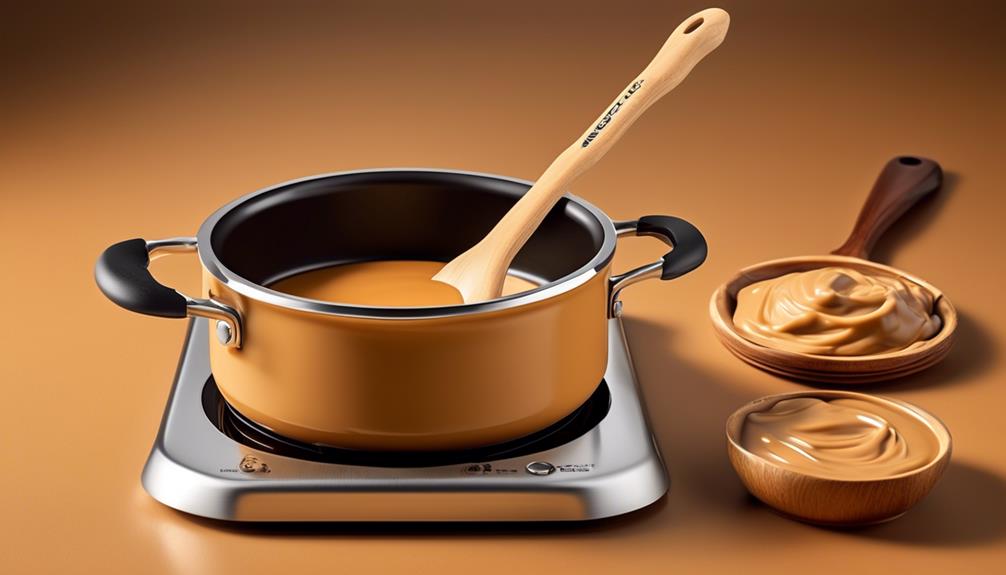
When melting the peanut butter, it's important to heat it gently to avoid burning. We want to achieve a smooth and flowing consistency without compromising the flavor.
Heating the Peanut Butter
How can we achieve the ideal drizzling consistency for peanut butter through the process of heating it? Heating peanut butter is essential to achieve the perfect drizzling consistency. We have two methods for this: the microwave and stovetop methods. In the microwave method, place a tablespoon of peanut butter in a microwave-safe bowl and heat it in 20-second intervals, stirring in between, until it reaches a spoonable consistency. Alternatively, the stovetop method involves heating the desired amount of peanut butter in a small skillet over low flame, stirring until it achieves a loose, runny texture suitable for drizzling. It's crucial to adjust the heating time and intensity based on the quantity and type of peanut butter to attain the perfect drizzling thickness. Exercise caution to prevent overheating or burning the peanut butter, and allow it to cool slightly before drizzling to achieve the desired texture.
| Method | Instructions |
|---|---|
| Microwave | Place a tablespoon of peanut butter in a microwave-safe bowl, heat in 20-second intervals, stirring. |
| Stovetop | Heat desired peanut butter amount in a small skillet over low flame, stirring until runny. |
Achieving Desired Consistency
To achieve the ideal drizzling consistency for peanut butter, it's crucial to carefully heat it using either the microwave or stovetop method, ensuring it reaches a spoonable or runny texture suitable for drizzling.
- Microwave Method:
- Heat peanut butter in 10-second increments, stirring in between, until it reaches a spoonable consistency.
- Stovetop Method:
- Place peanut butter in a skillet over low flame and heat, stirring constantly, until it achieves a runny consistency for drizzling.
- Adjusting Thickness:
- Experiment with water or heat to modify the thickness of powdered peanut butter for drizzling on various dishes.
Avoiding Burning the Peanut Butter
Carefully monitor the heating process of the peanut butter to avoid burning it, ensuring it reaches the desired drizzling consistency. When melting peanut butter, it's crucial to use gentle heat and frequent stirring to prevent burning. Here's a helpful guide to melting peanut butter without burning it:
| Heating Method | Time | Instructions |
|---|---|---|
| Microwave | 30-second intervals | Heat in short bursts, stirring in between until drizzling consistency is achieved. |
| Stovetop | Low heat | Use a double boiler or a heatproof bowl over simmering water, stirring constantly until the desired consistency is reached. |
Adding Liquid for Consistency
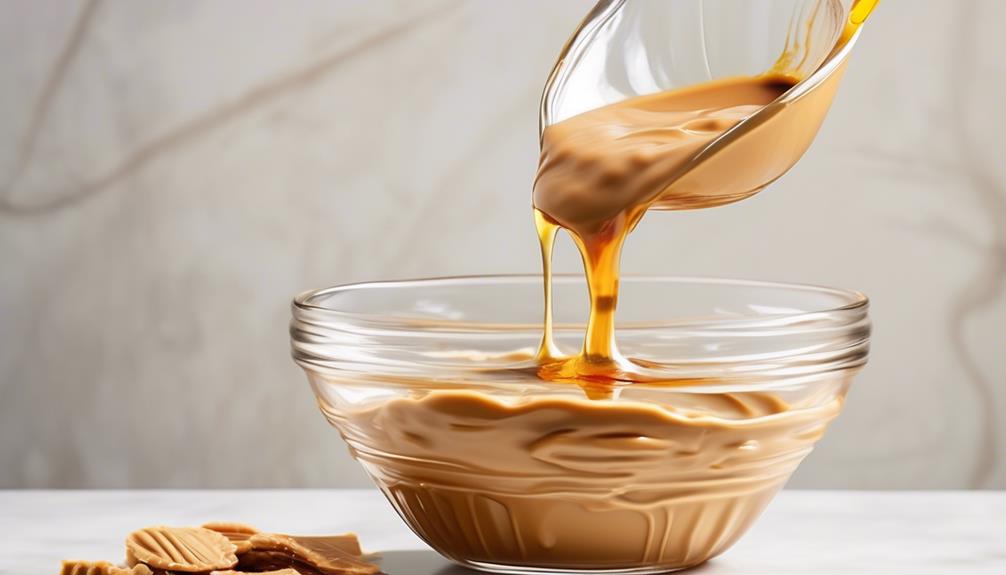
Consider adding a small amount of liquid, such as milk or water, to achieve the desired drizzling consistency of the peanut butter.
When adjusting the consistency of the peanut butter for drizzling, it's essential to proceed gradually, ensuring the perfect texture without making it too runny.
Here are some essential tips for adding liquid to achieve the ideal peanut butter drizzle consistency:
- Add the liquid gradually: Incorporate the liquid a little at a time, stirring thoroughly after each addition. This method allows for precise control over the consistency, preventing the peanut butter from becoming too thin.
- Use caution with heat: If using the microwave or stovetop to thin the peanut butter, be mindful of the heat application. Heat the peanut butter in short bursts or on a low flame, stirring in between, to prevent overheating and altering the texture.
- Adjust powdered peanut butter: When using powdered peanut butter, adjust the consistency by adding water or more powder. Aim for a thinner, drizzle-friendly texture that complements your dish or dessert perfectly.
Using a Drizzling Tool

After achieving the ideal drizzling consistency by carefully adding liquid, we can now focus on the precise application of the peanut butter using a drizzling tool. Using a drizzling tool ensures that the peanut butter is applied evenly and in a controlled manner, resulting in a professional-looking drizzle.
When selecting a drizzling tool, consider one with a narrow opening to allow for a fine stream of peanut butter to flow through. We recommend using a squeeze bottle or a piping bag with a small round tip for the best results.
To begin, fill the drizzling tool with the prepared peanut butter drizzle. Hold the tool slightly above the surface of the item you're drizzling and gently squeeze or pipe the peanut butter in a back-and-forth motion to achieve an even distribution. Take your time and maintain a steady hand to create a beautifully drizzled pattern.
Drizzling Techniques for Desserts
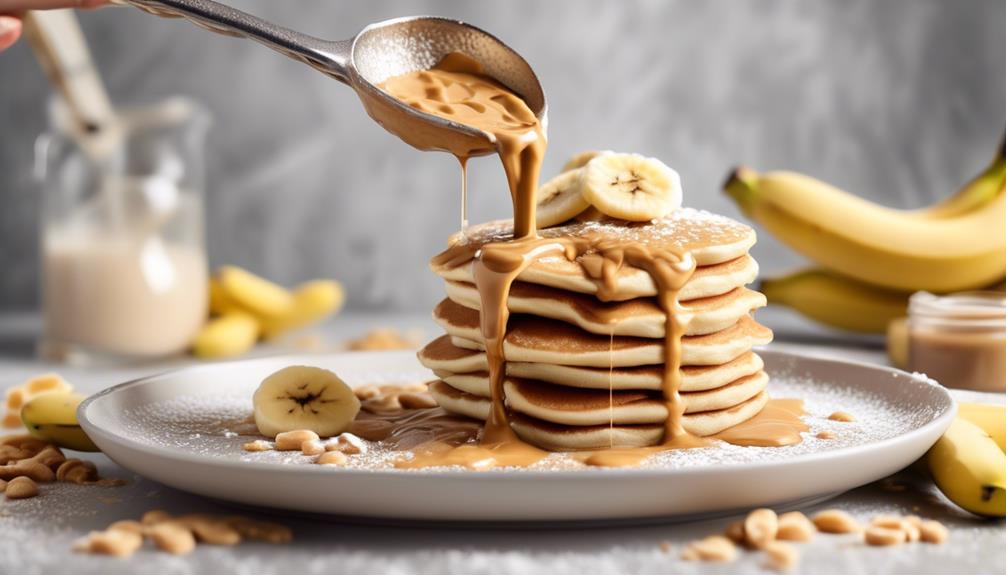
When it comes to drizzling techniques for desserts, it's crucial to consider the tools we use. Using a spoon can provide more control over the drizzle and allow for intricate designs on desserts.
On the other hand, utilizing a squeeze bottle can offer a more consistent and even distribution of the drizzle, ensuring a professional and polished presentation.
Each technique has its own advantages, and it's important to choose the method that best suits the specific dessert and desired aesthetic.
Drizzling With Spoon
To achieve a smooth and controlled drizzle on desserts, warm the peanut butter in the microwave or on the stovetop to achieve a spoonable consistency.
Here are the steps for drizzling with a spoon:
- Microwave Method:
- Place the desired amount of peanut butter in a microwave-safe bowl.
- Heat the peanut butter in 10-second increments, stirring in between, until it reaches a spoonable consistency.
- Use a tablespoon to scoop the warmed peanut butter and drizzle it over your dessert.
- Stovetop Method:
- Heat the peanut butter in a small skillet on low flame, stirring constantly until it reaches a loose, runny consistency.
- Once the peanut butter is ready, use a tablespoon to drizzle it over your dessert with precision.
- Alternative Option:
- Consider using almond butter for drizzling on waffles, pancakes, and acai bowls, following a similar thinning process.
Mastering the art of drizzling with a spoon takes practice, but the delicious results are well worth the effort!
Using Squeeze Bottle
Transitioning from drizzling with a spoon to utilizing a squeeze bottle allows for more precise and professional-looking patterns when adding peanut butter or other nut butters to dessert creations. The squeeze bottle offers better control over the flow and direction of the peanut butter drizzle.
To achieve this, ensure that the peanut butter is warm and smooth to easily flow through the nozzle. Fill the squeeze bottle with the desired amount of peanut butter, leaving some space at the top to prevent overflow. Squeeze gently and steadily to create thin lines or intricate designs on your desserts, adjusting the pressure to control the thickness of the drizzle.
Practice different hand movements to master the art of drizzling with a squeeze bottle, allowing for beautiful and appetizing presentations of your sweet treats.
Drizzling Techniques for Breakfast Foods
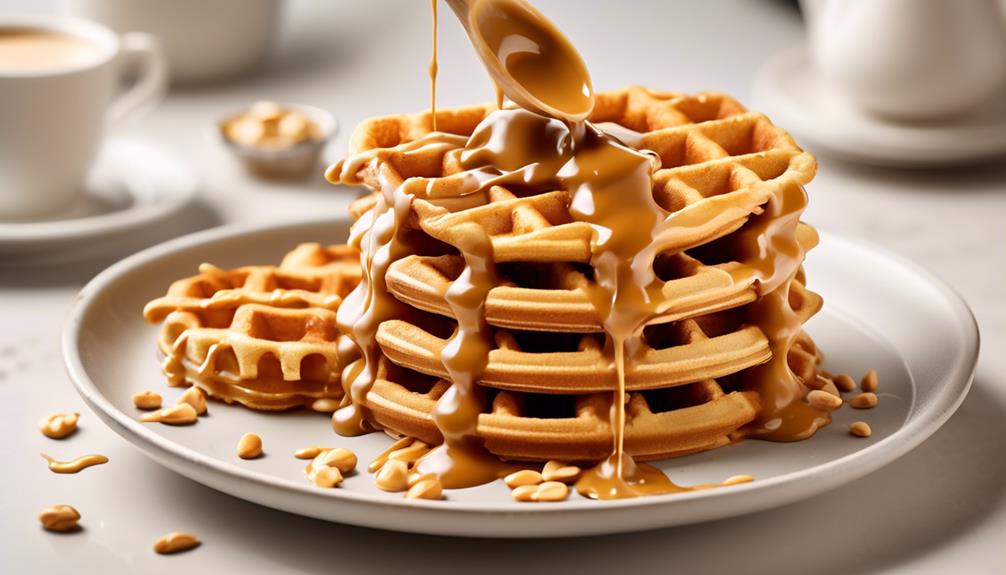
Utilizing different types of peanut butter and nut butters, along with adjusting their consistency through the heating process, can enhance the drizzling techniques for breakfast foods.
- Consistency is Key
- Adjust the thickness of the peanut butter drizzle with water or heat to achieve the perfect pour over pancakes, waffles, or oatmeal.
- Consider different types of peanut butter sauces for various applications, such as a creamy drizzle for yogurt or a thicker one for toast.
- Add additional ingredients like coconut oil or honey to prevent the peanut butter from hardening after drizzling onto cold items like smoothie bowls or fruit.
Experimenting with these techniques will allow you to create a delightful breakfast experience. Whether you prefer a classic peanut butter drizzle over your morning toast or a more adventurous spicy peanut butter sauce to add a kick to your dish, the possibilities are endless.
Additionally, don't hesitate to get creative by using the homemade peanut butter drizzle as a topping for your favorite breakfast pastries or mixing it with melted chocolate for a decadent peanut butter chocolate drizzle. By mastering these drizzling techniques, you can elevate your breakfast to a whole new level of deliciousness.
Drizzling Techniques for Snacks
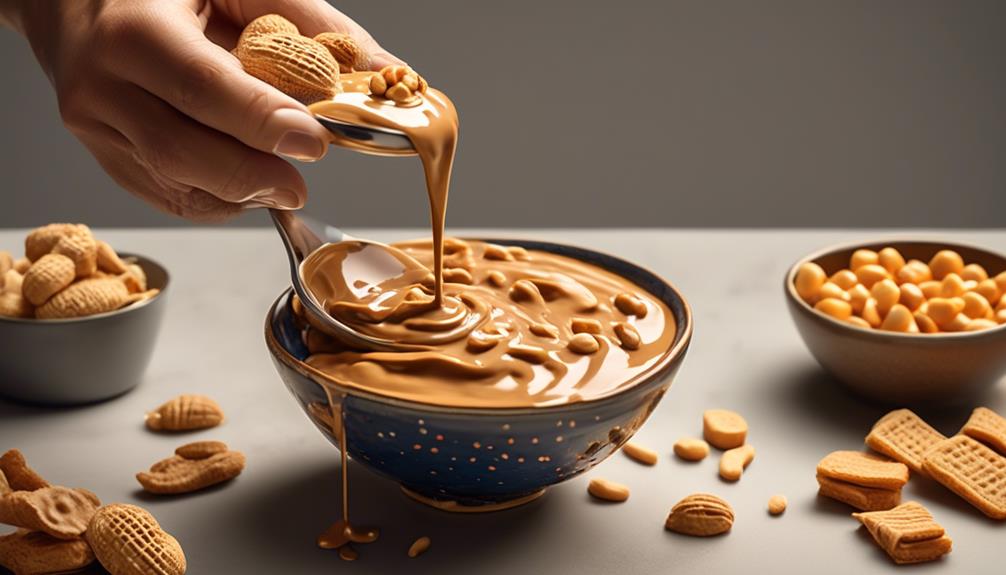
After perfecting the art of drizzling techniques for breakfast foods, we can now apply our expertise to elevate the snacking experience with innovative nut butter drizzles.
When it comes to drizzling techniques for snacks, precision is key to achieving a delightful flavor balance and aesthetic appeal. Using a piping bag is essential for achieving the perfect drizzle. The butter should be at a slightly warm temperature to ensure smooth flow through the piping bag. It's crucial to gently warm the nut butter and then transfer it into a piping bag, ensuring that the opening is small enough to control the flow but large enough to prevent clogging.
When drizzling over snacks such as sliced fruits, pretzels, or popcorn, hold the piping bag slightly above the snack and move it in a fluid, steady motion. This technique allows for an even distribution of the nut butter drizzle, enhancing the snacking experience.
Mastering the art of drizzling techniques for snacks will undoubtedly take your snacking game to the next level, offering a delectable and visually appealing treat.
Flavor Variations for Peanut Butter Drizzle
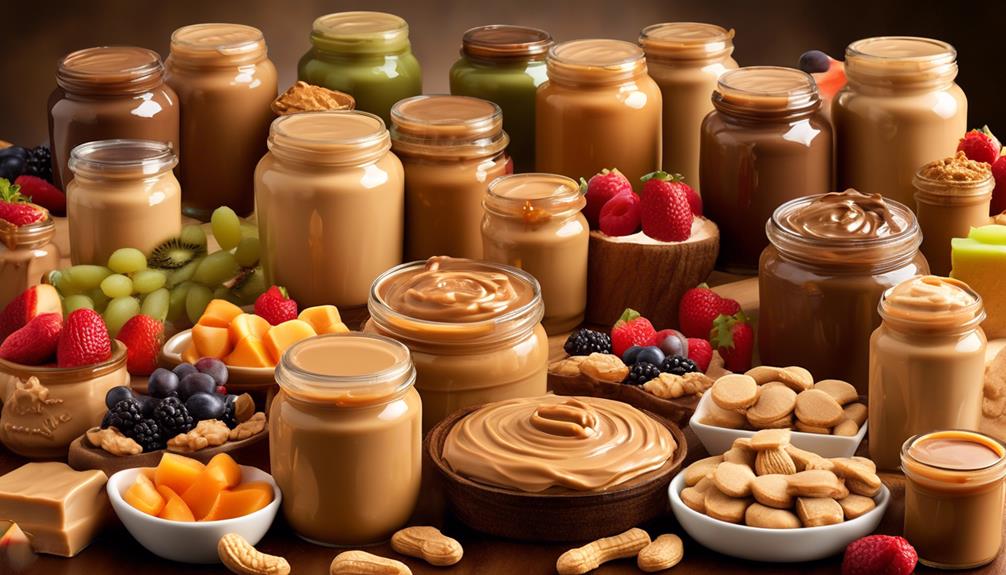
To enhance the peanut butter drizzle, consider infusing it with complementary flavors such as honey, cinnamon, or a hint of sea salt to elevate the taste profile and appeal to various palates.
- Honey Infusion
Incorporating honey into the peanut butter drizzle adds a natural sweetness and a subtle floral aroma, creating a harmonious blend of flavors that delights the taste buds. The viscosity of honey also contributes to the smoothness and consistency of the drizzle, enhancing its overall texture.
- Cinnamon Blend
Adding a touch of cinnamon to the peanut butter drizzle introduces warm, earthy notes that complement the nuttiness of the peanut butter, resulting in a rich and aromatic flavor profile. Cinnamon's natural warmth can evoke a sense of comfort and indulgence, making the drizzle an enticing addition to various snacks and desserts.
- Sea Salt Infusion
A hint of sea salt in the peanut butter drizzle creates a delightful contrast of sweet and savory, intensifying the flavors and providing a satisfying depth of taste. The subtle saltiness also helps to balance the sweetness of the drizzle, enhancing its overall complexity and making it a versatile accompaniment to a wide range of treats.
Storing and Reheating Drizzled Items
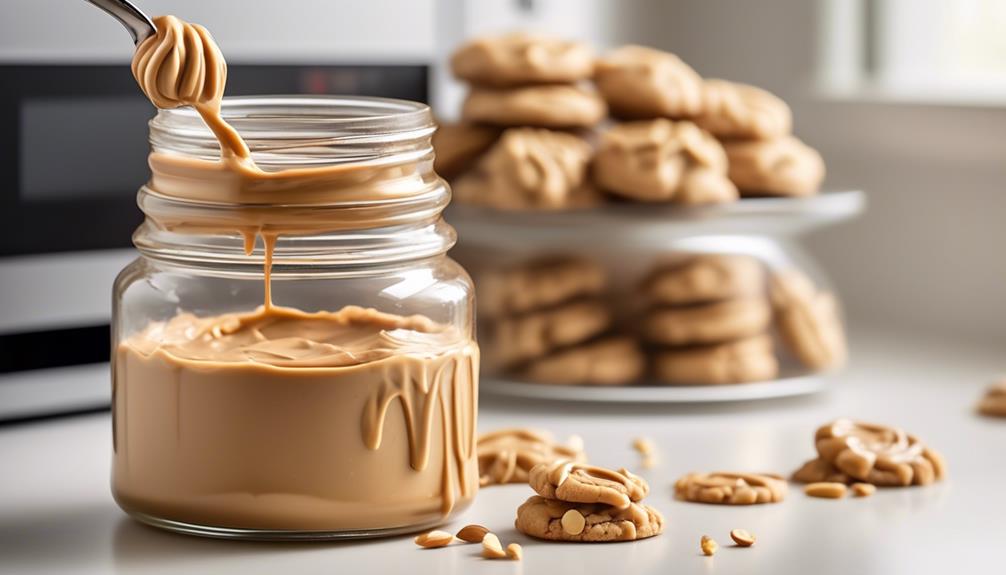
Enhancing the peanut butter drizzle with complementary flavors such as honey, cinnamon, or sea salt not only elevates its taste profile but also necessitates an understanding of the best methods for storing and reheating drizzled items to maintain their quality and flavor.
When storing drizzled items, it's essential to ensure that they're kept in airtight containers to prevent moisture from affecting the texture of the drizzle. Refrigeration is generally recommended for items like pastries or fruits drizzled with peanut butter to prolong their shelf life. However, if you're drizzling items that are best enjoyed at room temperature, such as ice cream or pancakes, it's crucial to store them in a cool, dry place away from direct sunlight.
When reheating drizzled items, it's important to do so gently to avoid compromising the texture and flavor of the peanut butter drizzle. For items like pancakes or waffles, a quick stint in the toaster or a few seconds in the microwave can help to restore the drizzle's gooey consistency. For drizzled fruits, a brief warming in the oven can enhance the flavors without causing the peanut butter to become overly runny.
Frequently Asked Questions
How Do You Melt Peanut Butter to Drizzle?
We melt peanut butter to drizzle by placing it in a microwave-safe bowl and heating it in short intervals, stirring in between, until it reaches a smooth, pourable consistency. This process ensures that the peanut butter doesn't burn and maintains its desired texture.
It's important to monitor the melting process closely to achieve the perfect drizzling consistency for your culinary creations.
How Do You Liquify Peanut Butter?
We liquify peanut butter by gently heating it in the microwave or on the stovetop, stirring frequently to achieve a smooth, pourable consistency. This process enhances the texture and makes it easier to drizzle over desserts or snacks.
It's important to avoid overheating to prevent burning or altering the flavor. We've found this method to be effective for creating a delectable peanut butter drizzle.
What Can I Add to Peanut Butter to Make It Runny?
To make peanut butter runny, we add oils like vegetable or coconut oil. Gently heat the peanut butter and slowly incorporate the oil until desired consistency is reached.
This method ensures a smooth, pourable texture perfect for drizzling over pancakes or ice cream. Be mindful of the amount of oil added, as it can alter the flavor. Experiment with small quantities for optimal results.
How Do You Thin Melted Peanut Butter?
To thin melted peanut butter, we stir in small amounts of water or oil until it reaches our desired consistency. This helps to make it easier to drizzle and prevents it from hardening too quickly.
We can also use heat to make the peanut butter more runny, either by warming it in the microwave or on the stovetop.
Experimenting with these methods will help us achieve the perfect peanut butter drizzle for our favorite dishes.
Conclusion
In conclusion, mastering the art of peanut butter drizzling can elevate any dish to new heights of deliciousness.
By carefully selecting the right peanut butter, melting it to perfection, and adjusting the consistency with liquid, you can create a drizzle that will impress and delight.
With the right drizzling techniques and flavor variations, you can take your culinary creations to the next level.
So go ahead and become a peanut butter drizzle master!
From sneaky childhood butter licks to penning some of our most popular articles, Jamie’s journey with butter has been lifelong. His culinary background gives him a unique perspective, allowing him to craft mouthwatering articles that educate and tantalize equally. Jamie’s travel adventures revolve around finding the world’s best buttery treats when he isn’t writing.
Peanut Butter
Exploring Peanut Butter Price Trends: Factors Impacting Cost
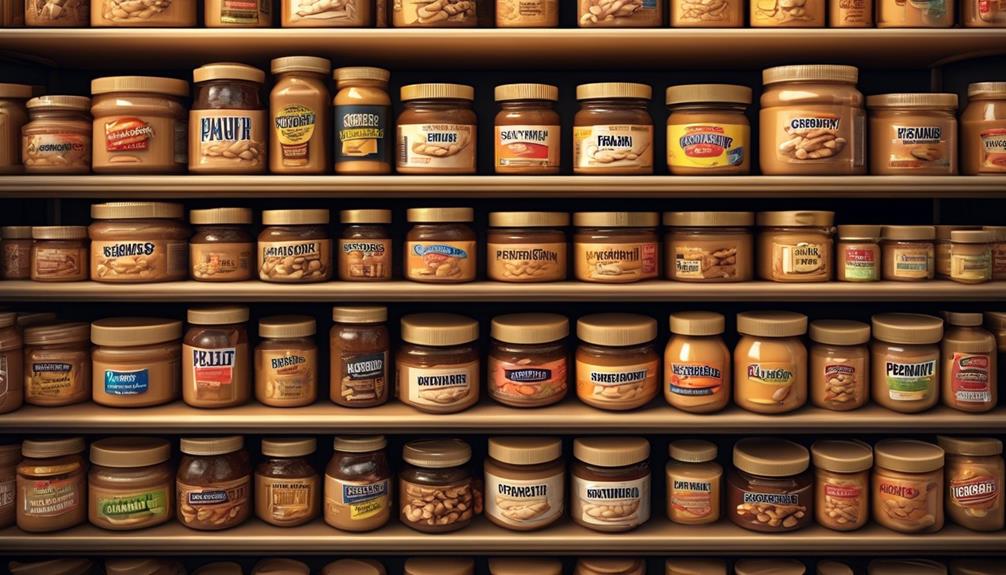
We've all experienced the sticker shock at the grocery store when we reach for our favorite jar of peanut butter, only to find that the price has increased yet again. It leaves us wondering, why is peanut butter so expensive?
Well, there are several factors at play that contribute to the price of this beloved spread. From the cost of peanuts themselves to the impact of market demand and branding, the reasons behind the price of peanut butter might surprise you.
Let's explore the various factors that make peanut butter price what it is and uncover the complexities behind this pantry staple.
Key Takeaways
- Adverse weather conditions and reduced peanut production are contributing factors to the increase in peanut butter pricing.
- High demand for peanut butter among health and fitness enthusiasts is driving up its price.
- Marketing efforts and branding strategies play a role in the higher pricing of peanut butter.
- Packaging and perceived value also impact the pricing of peanut butter.
Factors Affecting Peanut Butter Pricing
Experiencing a shortage due to sweltering temperatures and smaller crops, peanut butter pricing is being affected by various factors in the market.
The Peanut Belt states of Georgia and Texas, which usually yield substantial peanut crops, have been hit by adverse weather conditions, leading to a decrease in peanut production. This scarcity has a direct impact on peanut butter prices, as the reduced supply drives up costs for manufacturers. Companies such as J.M. Smucker Co. are already planning to raise prices in response to the smaller crop, further contributing to the increase in peanut butter pricing.
Additionally, the high demand for peanut butter, fueled by its popularity among health and fitness enthusiasts, as well as shifting consumer preferences, has played a significant role in driving up its cost. Furthermore, the marketing efforts and branding strategies employed by peanut butter companies to stand out in the competitive peanut butter market have also contributed to the higher pricing of peanut butter.
The cost of storing and handling peanuts, including additional expenses for proper storage and transportation, further influences the pricing of peanut butter.
These multiple factors combined have led to the current state of peanut butter prices, making it essential for consumers to find peanut butter that fits within their budget.
Influence of Market Demand
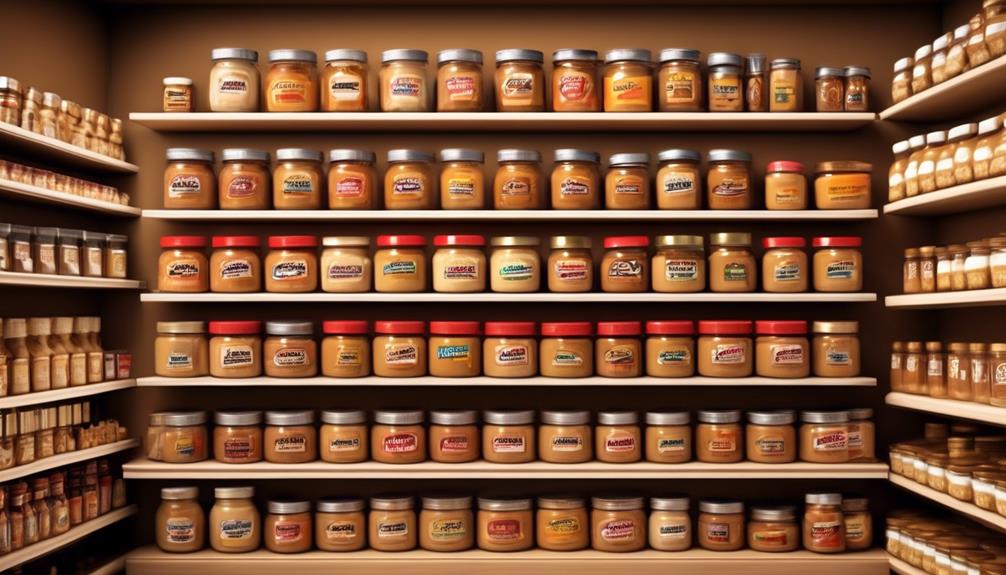
The high demand for peanut butter, driven by its popularity among health and fitness enthusiasts, significantly influences its market pricing. As the demand for peanut butter rises, so does its price. This increase in demand has a direct impact on the cost of peanut butter, driving it up as suppliers and producers seek to capitalize on the market trend.
This is evident in the current pricing, where peanut butter prices have risen by several cents per unit due to the surge in demand. The market demand for peanut butter not only affects its retail cost but also influences various factors contributing to its pricing, such as production, marketing, and distribution.
Additionally, the competitive nature of the market further propels the pricing of peanut butter, as brands invest heavily in marketing to differentiate themselves, passing on these costs to consumers. Moreover, limited availability in certain regions due to imports results in higher transportation and importation costs, further elevating the price of peanut butter.
Therefore, the influence of market demand plays a pivotal role in determining the price of peanut butter, affecting consumers' purchasing power and consumption patterns.
Impact of Branding on Price

When considering the impact of branding on the price of peanut butter, it's crucial to analyze the relationship between brand reputation and pricing.
Packaging plays a significant role in shaping consumers' perceived value of the product, which directly influences pricing strategies.
Additionally, the influence of advertising on consumer perception and pricing strategy can't be overlooked.
Brand Reputation and Price
Brand reputation significantly influences the pricing of peanut butter. Market-dominating brands like J.M. Smucker Co. are able to command higher prices due to their strong brand recognition and reputation. This is because their brand reputation gives consumers the perception of quality and reliability, allowing them to justify paying a premium price. The cost of marketing efforts, including sophisticated branding and organic credentials, is passed on to consumers, further impacting the price of peanut butter.
However, for consumers looking to avoid paying premium prices associated with fancy branding, store brands or budget options offer a more affordable alternative. These brands often have lower marketing costs, allowing them to offer peanut butter at a lower price point.
In addition to brand reputation, there are other factors that contribute to the overall price of peanut butter. The cost of ensuring peanuts are stored correctly, transportation and importation costs, and the manufacturing process all play a role in determining the final price. These costs are influenced by brand reputation and the associated production and handling costs.
Even within leading brands like Jif and Skippy, there are different pricing strategies. Wholesale clubs, for example, often offer competitive prices for both generic and name brand peanut butter. This illustrates the impact of brand reputation on pricing within the market.
Packaging and Perceived Value
Analyzing the impact of packaging on perceived value reveals the intricate relationship between branding and pricing in the peanut butter market.
- Packaging creates a visual and psychological connection, influencing consumers' perception of quality and value.
- Branding and packaging convey a story and lifestyle, enticing consumers to associate higher value with certain brands.
- Innovative and sustainable packaging designs can elevate the perceived value, justifying premium pricing for peanut butter products.
The packaging of peanut butter plays a pivotal role in shaping consumers' perception of its value. It serves as a tangible representation of the brand and its quality, influencing purchasing decisions. As consumers, we're drawn to packaging that communicates quality and aligns with our values, ultimately impacting the price we're willing to pay for peanut butter.
Advertising and Pricing Strategy
The impact of packaging on perceived value in the peanut butter market underscores the significance of advertising and branding efforts in shaping pricing strategies for different brands.
As companies invest in marketing to differentiate themselves and appeal to health-conscious consumers, these efforts significantly influence the pricing of peanut butter. The costs associated with marketing and branding are ultimately passed on to the buyers, contributing to the overall price of peanut butter. This phenomenon makes store brands or budget options an attractive cost-saving alternative for price-conscious consumers.
Additionally, the effective communication of product benefits and unique selling propositions through advertising can justify premium pricing for certain brands. Therefore, advertising and branding play a pivotal role in determining the perceived value of peanut butter, enabling companies to implement diverse pricing strategies to cater to varying consumer segments and preferences.
Cost of Peanuts Storage

Proper storage and transportation of peanuts significantly impact their quality and directly influence the pricing of peanut butter. The cost of ensuring peanuts are stored correctly is reflected in the pricing of peanut butter. Careful handling and storage are necessary to maintain the quality of peanuts. The high fat content of peanuts makes them difficult to store, requiring specific conditions to prevent spoilage.
The proper storage and transportation of peanuts incur additional costs for manufacturers. Incorrectly stored peanuts develop a chemical-like smell and taste bitter or sour, making them unsuitable for peanut butter production. These factors emphasize the importance of investing in adequate storage facilities and transportation methods to maintain the integrity of the peanuts used in peanut butter production.
The cost of peanuts storage is a crucial aspect that directly impacts the overall price of peanut butter. Manufacturers must bear the expenses associated with maintaining optimal storage conditions to ensure the peanuts' quality, which inevitably influences the final pricing of peanut butter for consumers.
Import Challenges for Peanut Butter

Importing peanut butter from countries with limited peanut cultivation presents significant challenges, impacting transportation costs and availability. Limited peanut cultivation in certain countries leads to a heavy reliance on imports, resulting in increased transportation and importation costs. Additionally, importing peanut butter from countries with different growing conditions can lead to higher prices due to limited availability and increased demand. This directly affects the price and accessibility of peanut butter in the United States, making it challenging for some regions to obtain at a reasonable cost.
Expats living abroad often face difficulties in obtaining peanut butter due to limited availability and higher costs of imported peanut butter. As a result, they often rely on friends and family to bring peanut butter when visiting. The availability and demand for peanut butter in different countries further complicate the import challenges, ultimately leading to increased prices for consumers. The additional expenses incurred in the transportation and importation processes contribute to the overall price of peanut butter in the market.
Manufacturing Process Costs
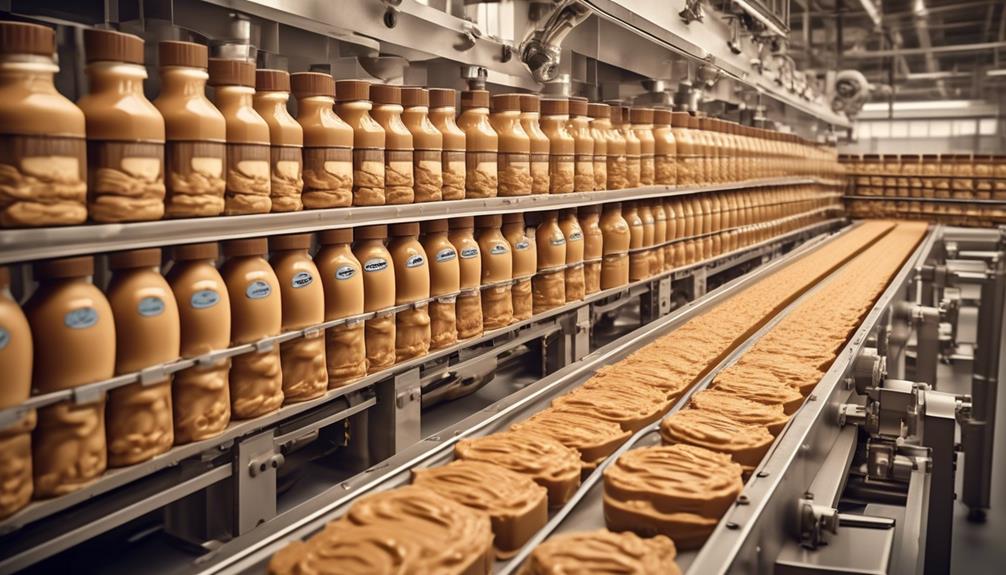
The manufacturing process costs of peanut butter are a crucial aspect of pricing analysis.
Ingredient sourcing and packaging expenses play a significant role in determining the overall manufacturing costs.
We must carefully examine these specific points to understand the impact on the pricing of peanut butter.
Ingredient Sourcing
Investing in equipment, research, and development to meet consumer demands for quality and variety adds to the manufacturing process costs of peanut butter. The sourcing of raw nuts like peanuts significantly impacts these costs. Factors such as crop yield, careful handling, and storage needs influence the overall manufacturing expenses.
Additionally, the cost of transporting and importing peanuts for peanut butter production contributes to the total manufacturing process costs. Furthermore, the cost of raw materials and production processes varies across different nut butters, with factors like the cost of growing and processing peanuts versus almonds contributing to overall price differences.
Understanding these intricacies illuminates the multifaceted nature of peanut butter and nut butter pricing, providing insight into the complexities involved in the ingredient sourcing process.
Packaging Expenses
Careful consideration of packaging expenses is crucial for manufacturers to maintain product quality and appeal to consumers while managing production costs.
Packaging expenses encompass the costs associated with designing, manufacturing, and labeling the containers used to store and sell products like peanut butter and jelly. These costs include materials such as glass, plastic, or metal, as well as the labor and machinery needed for the packaging process.
Additionally, packaging expenses involve the development of attractive and informative labels to appeal to consumers and comply with regulations.
Efficient and sustainable packaging solutions can help minimize expenses and reduce environmental impact, benefitting both the manufacturer and the consumer.
When it comes to a jar of peanut butter or homemade peanut butter, smart packaging decisions can significantly impact the overall cost and consumer perception.
Homemade Vs. Store-Bought Peanut Butter

When considering the decision between homemade and store-bought peanut butter, consumers can weigh the advantages and disadvantages of each option to make an informed choice.
Homemade peanut butter allows for control over ingredients and customization, offering a healthier alternative to store-bought options that may contain added sugars and preservatives. On the other hand, store-bought peanut butter provides convenience and a variety of flavors, catering to diverse consumer preferences.
Additionally, homemade peanut butter can be less expensive, especially when using bulk nuts, compared to premium store-bought options, contributing to cost savings without compromising quality.
In weighing the decision between homemade and store-bought peanut butter, consumers should consider their priorities, whether it's the desire for healthier ingredients, flavor variety, or cost-effectiveness. These factors can guide individuals towards the option that best aligns with their preferences and values.
Frequently Asked Questions
Why Is Peanut Butter so Expensive Now?
Peanut butter is so expensive now due to a combination of factors.
Sweltering temperatures and drought have led to a decreased peanut crop, causing a shortage.
The dominant market player plans to raise prices by 30% due to the shortage.
High demand, sophisticated branding, and marketing efforts also contribute to the increased cost.
Additionally, the cost of storing, handling peanuts, and the manufacturing process adds to the overall price.
Why Is There a Peanut Butter Shortage?
The peanut butter shortage stems from a 13% smaller peanut crop caused by extreme heat and parched soil in the Peanut Belt states.
This shortage has prompted major players like J.M. Smucker Co. to forecast a 30% price increase in November.
High demand, especially from health and fitness enthusiasts, has further driven up costs.
Additionally, the branding and marketing efforts of companies, as well as the costs of storing and handling peanuts, all contribute to the pricing of peanut butter.
Why Are Peanuts so Expensive 2023?
Peanuts are expensive in 2023 due to a combination of factors. Crop damage from extreme weather conditions has reduced harvest sizes, leading to a scarcity of peanuts. Major companies dominating the market have driven up prices. High demand, influenced by popularity and health benefits, has also played a role.
Additionally, costs related to branding, marketing, and production processes contribute to the expensive nature of peanuts.
Why Is Jif so Expensive?
We believe Jif is expensive due to multiple factors.
The 13% decrease in this year's peanut crop, sweltering temperatures, and parched soil in Peanut Belt states like Georgia and Texas have impacted production.
J.M. Smucker Co., dominating 45% of the peanut butter market, expects to raise prices by 30% in November.
Additionally, high demand, marketing efforts, and the cost of storing and handling peanuts contribute to the overall expense of Jif.
Conclusion
In conclusion, the price of peanut butter is influenced by a complex interplay of factors, much like a symphony orchestra with each instrument playing a crucial role in creating the final masterpiece.
From the cost of peanuts to the impact of market demand and branding, every component contributes to the overall price.
Understanding these factors can help consumers make informed decisions and appreciate the value behind their favorite spread.
From sneaky childhood butter licks to penning some of our most popular articles, Jamie’s journey with butter has been lifelong. His culinary background gives him a unique perspective, allowing him to craft mouthwatering articles that educate and tantalize equally. Jamie’s travel adventures revolve around finding the world’s best buttery treats when he isn’t writing.
Peanut Butter
What Makes Peanut Butter Whiskey Unique?

So, you're curious about peanut butter whiskey? Well, it's certainly an intriguing concept, isn't it?
The idea of blending the rich, nutty flavor of peanut butter with the warmth of whiskey is something that piques the interest of many.
But how does it actually taste? Is it a gimmicky novelty or a genuinely enjoyable spirit?
Let's explore the world of peanut butter whiskey and uncover what makes it a standout in the realm of flavored spirits.
Key Takeaways
- Peanut butter whiskey offers a unique flavor profile, combining the rich, nutty taste of peanut butter with the smooth warmth of whiskey.
- It appeals to both whiskey enthusiasts and those with a sweet tooth, offering a velvety, nutty sweetness on the palate.
- With an initial aroma reminiscent of freshly ground peanuts, it provides a familiar and comforting warmth of whiskey on the finish.
- Peanut butter whiskey has gained popularity due to its exceptional taste, appealing to those who prefer sweeter alcohol options and expanding the flavored whiskey market in the United States.
Peanut Butter Whiskey: A Unique Flavor Profile
Peanut butter whiskey offers a unique flavor profile that combines the rich, nutty taste of peanut butter with the smooth warmth of whiskey, creating a distinctive and indulgent drinking experience.
The marriage of whiskey and peanut butter creates a surprisingly delightful fusion that appeals to both whiskey enthusiasts and those with a sweet tooth. This flavored whiskey introduces a whole new dimension to the world of spirits, challenging traditional notions of what whiskey can be.
The initial aroma is reminiscent of freshly ground peanuts, followed by a velvety, nutty sweetness on the palate, which then gives way to the familiar, comforting warmth of whiskey as it goes down. The interplay of these flavors creates a truly unique drinking experience that's both familiar and novel at the same time.
The balance between the distinct nuttiness and the classic whiskey notes is what sets peanut butter whiskey apart, making it an intriguing choice for those seeking a departure from conventional whiskey flavors.
Understanding the Alcohol Content
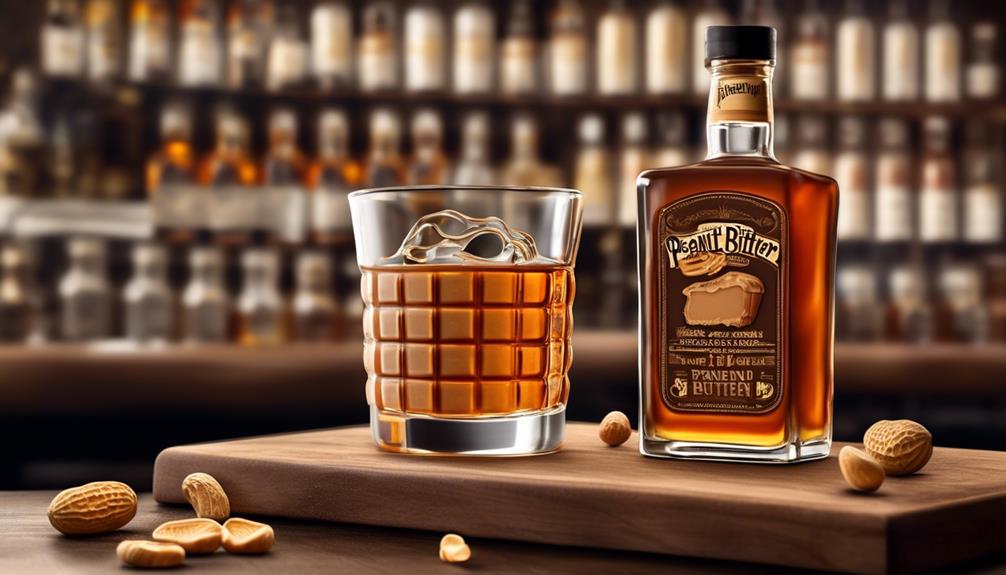
As we continue our exploration of peanut butter whiskey's unique qualities, it's important to understand the alcohol content of this distinct spirit and how it sets it apart from traditional whiskeys.
Unlike typical American whiskey, peanut butter whiskey is known for its lower alcohol percentage, ranging from 30 to 35%, approximately 70 proof, which is notably lower than traditional whiskey's 80 proof. While this places it outside the classification of Scotch whisky according to EU standards, peanut butter whiskey doesn't make such claims.
Despite its lower alcohol by volume (ABV), the whiskey flavored with peanut butter has gained popularity due to its exceptional taste, appealing particularly to those who prefer sweeter alcohol or who previously believed they didn't enjoy whiskey.
For those interested in understanding the alcohol content of different brands, Bartendr provides a comprehensive guide, offering a roundup of the most common peanut butter whiskey brands and their alcohol percentages. This knowledge is crucial for consumers to make informed decisions before purchasing or selecting serving sizes.
Understanding the distinctive alcohol content of peanut butter whiskey is essential to fully appreciate its unique qualities and make the most of this flavorful spirit.
Serving Suggestions and Pairings
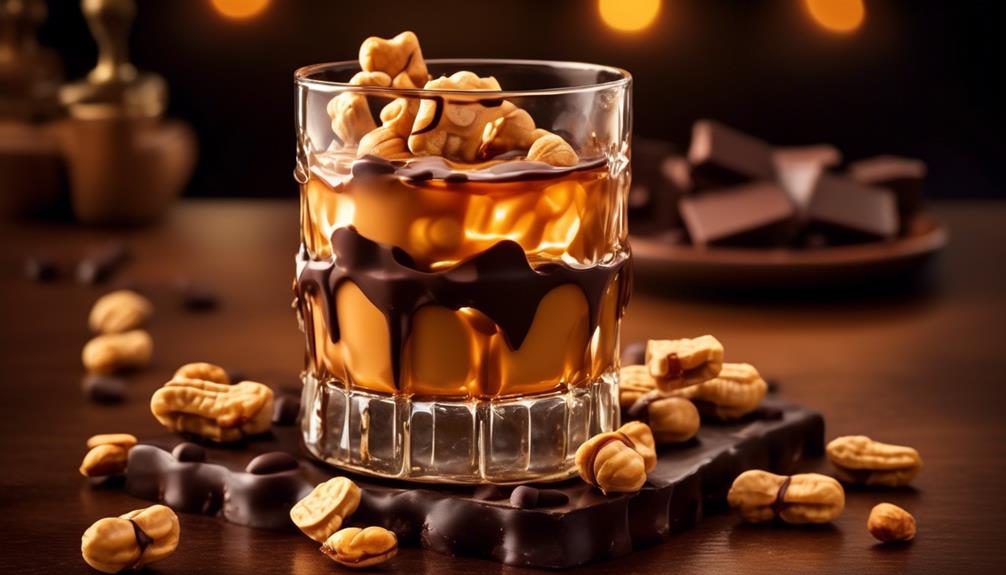
When considering serving suggestions and pairings for Skrewball Peanut Butter Whiskey, various options allow for a versatile and enjoyable drinking experience. Skrewball can be savored neat, on the rocks, or with a splash of water, enhancing its delightful aromatics and flavors.
Additionally, the whiskey can be paired with jammy cassis for a delightful enhancement of fruity flavors, or added to an old-fashioned cocktail for a nutty twist. For those seeking to experiment, mixing Skrewball with alcohols like RumChata, vanilla vodka, and caramel liqueur offers rich and complementary flavors.
Alternatively, trying it with coffee, Coca-Cola, apple cider, berry-flavored seltzer, or chocolate milk provides unique one-ingredient mixers. The versatility of Skrewball opens up new possibilities for whiskey enthusiasts to explore and enjoy creative cocktail combinations.
For further inspiration, the Skrewball website offers additional serving suggestions and cocktail recipes to elevate your next drink with this distinctive flavored whiskey. With these options, Skrewball Peanut Butter Whiskey promises an exciting and flavorful drinking experience.
Exploring Popular Peanut Butter Whiskey Brands

With the rise in popularity of flavored whiskies, a new category has emerged, introducing unique and unconventional flavors to the market. Among these, peanut butter whiskey has garnered significant attention. One of the most popular brands in this category is Skrewball Peanut Butter Whiskey, which has made a mark with its genuine peanut butter aroma and taste. This American whiskey flavored with peanut butter has gained a devoted following due to its unconventional yet enjoyable drinking experience. Created by Steven Yeng and his wife Brittany in San Diego, this flavored whiskey has experienced remarkable growth, evidenced by a staggering 1,976% increase in 2021 and its subsequent acquisition by drinks giant Pernod Ricard in 2023.
The rise of Skrewball Peanut Butter Whiskey also reflects the expanding flavored whiskey market in the United States, with major brands like Fireball, Jim Beam, and Jack Daniels venturing into this space. Skrewball, made with a base of corn and barley, infused with natural flavors, has become renowned for its refusal to provide extensive technical information, emphasizing its unique flavor profile. This versatile whiskey can be enjoyed on its own, mixed in cocktails, or paired with various flavors, offering a creative and adaptable drinking experience.
Making the Most of Skrewball Whiskey
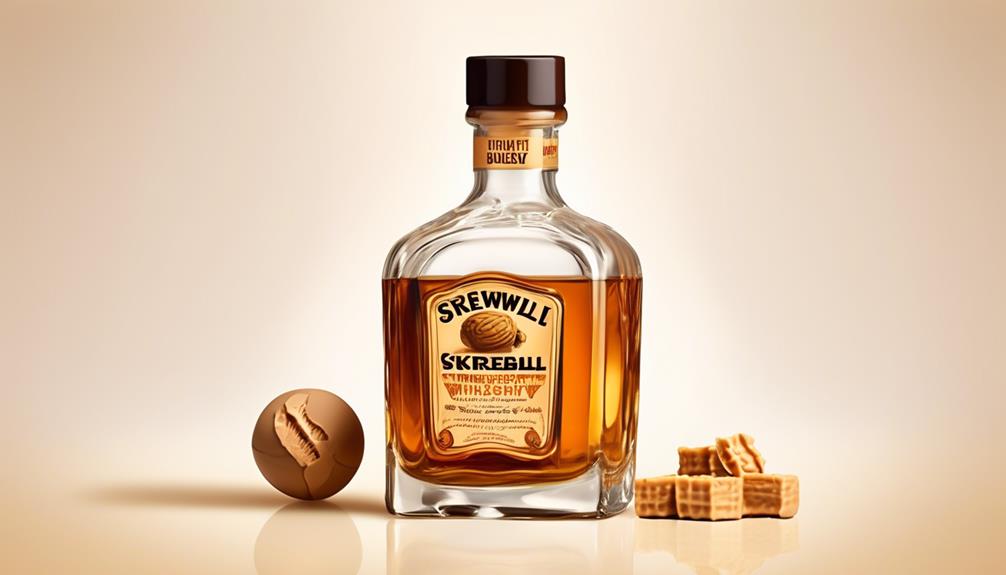
Exploring the versatility and unique flavor profile of Skrewball Peanut Butter Whiskey allows for a delightful and adaptable drinking experience, making it a standout choice in the flavored whiskey market. Skrewball isn't only a delightful sipping whiskey but also a versatile ingredient for crafting innovative cocktails.
Here's how to make the most of Skrewball Whiskey:
- Mixology Mastery: Experiment with Skrewball in classic cocktails like Old Fashioneds or create your own unique concoctions to elevate your mixology skills.
- Decadent Desserts: Infuse your desserts with the rich, nutty flavor of Skrewball, adding a delightful twist to your culinary creations.
- Liquor Store Finds: Seek out Skrewball at your local liquor store and explore the endless possibilities it offers for your home bar.
- Unconventional Pairings: Pair Skrewball with unexpected flavors like chocolate, banana, or even chili for an adventurous tasting experience.
- Whiskey-Flavored Adventures: Take your taste buds on a journey by incorporating Skrewball into your next whiskey tasting session, and savor its unique aroma and taste.
Skrewball Peanut Butter Whiskey opens up a world of flavor possibilities, perfect for those seeking a departure from traditional whiskey experiences.
Mixing and Cocktail Recipes
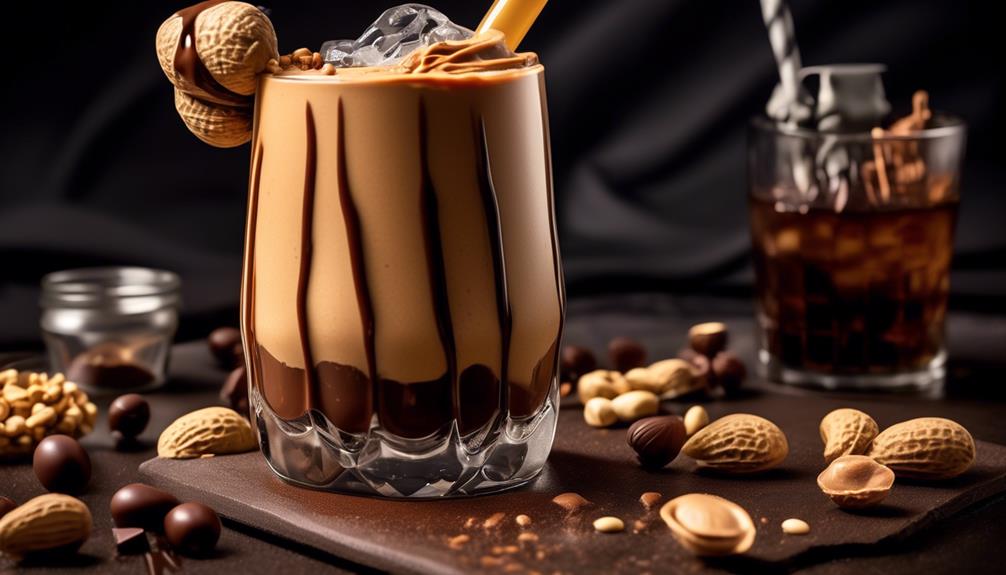
Let's dive into the art of mixing and crafting delectable cocktail recipes using Skrewball Peanut Butter Whiskey, adding a unique twist to traditional libations. Skrewball Peanut Butter Whiskey offers a delightful combination of whiskey flavored with the nutty richness of peanut butter, allowing for the creation of innovative cocktail recipes that tantalize the taste buds. Experimenting with mixing Skrewball with ingredients like jammy cassis, old-fashioned mixers, or complementary spirits such as RumChata and vanilla vodka can result in rich and distinct flavors. The versatility of Skrewball enables the crafting of unique cocktails, including the Graper Manhattan or the Peanut Butter and Honey Old-Fashioned (Winnie's Cup). When mixing Skrewball, it's crucial to consider its sweetness and balance it with other flavors to create well-rounded and enjoyable cocktails. For further inspiration, Skrewball's website offers a variety of well-balanced cocktail recipes, providing guidance for those looking to explore the distinct flavor profile of peanut butter whiskey in mixed drinks.
| Mixing Ideas | Cocktail Recipes |
|---|---|
| Jammy Cassis | Graper Manhattan |
| Old-Fashioned Mixers | Peanut Butter and Honey Old-Fashioned |
| Complementary Spirits (RumChata) | – |
Where to Find Peanut Butter Whiskey

We can easily find popular brands of peanut butter whiskey at our local liquor stores, such as Skrewball, Sheep Dog, and Ole Smoky.
If we prefer the convenience of online shopping, various retailers and alcohol delivery services offer peanut butter whiskey for purchase and delivery.
Additionally, Total Wine is a great option for those seeking a diverse selection of peanut butter whiskey, while specific venues like OB Noodle House Bar 1502 in San Diego may offer the original Skrewball peanut butter whiskey.
Popular Brands Available
Peanut butter whiskey has gained popularity in recent years, with several notable brands like Skrewball, Sheep Dog, and Ole Smoky entering the flavored whiskey market and becoming readily available at liquor stores across the U.S.
- Skrewball Peanut Butter Whiskey offers a genuine peanut butter aroma and taste, providing a unique drinking experience.
- The market has seen significant growth, with major brands like Skrewball, Sheep Dog, and Ole Smoky entering the flavored whiskey market.
- You can find peanut butter whiskey at practically any liquor store in the U.S. and online through retailers like Total Wine.
- Peanut butter whiskey typically has a lower alcohol percentage, around 30-35% ABV, making it sweeter and suitable for mixed drinks.
- Skrewball Peanut Butter Whiskey can be enjoyed alone, in cocktails, or paired with complementary flavors, offering new possibilities for whiskey enthusiasts.
Online and Local Stores
With the growing availability of peanut butter whiskey at both online and local liquor stores, enthusiasts can easily explore a wide range of popular brands such as Skrewball, Sheep Dog, and Sqrrl, as well as other lesser-known options. Check out the table below to discover where you can find these delectable bottles:
| Store | Online Availability | Physical Locations |
|---|---|---|
| Total Wine | Yes | Yes |
| OB Noodle House | No | Yes (San Diego) |
| Bartendr | Yes | No |
| Local Liquor Stores | Varies | Yes |
Peanut butter whiskey, a creation often likened to the nostalgic flavors of peanut butter and jelly, is now easily accessible for both online and in-store purchases. Whether you're seeking the original Skrewball peanut butter whiskey that's a San Diego specialty or looking to explore new flavors like raspberry liqueur-infused options, the options are plentiful. Steven Yeng's innovative fusion of whiskey and peanut butter has truly revolutionized the spirit market.
Specialty Liquor Shops
Exploring specialty liquor shops allows enthusiasts to discover a diverse selection of peanut butter whiskey brands and unique variations, offering a rich opportunity for expanding one's palate and exploring the world of flavored spirits. When seeking out peanut butter-flavored whiskey, specialty liquor shops are an ideal destination due to their distinct advantages:
- They often carry a range of peanut butter whiskey brands, including popular options like Skrewball, Sheep Dog, Ole Smoky, and Skatterbrain.
- Many offer online purchasing and delivery options for convenient access.
- Some stock exclusive or limited edition peanut butter whiskey variations.
- Knowledgeable staff can offer guidance on selection, serving suggestions, and cocktail recipes.
- Visiting provides an opportunity to explore other unique flavored spirits, expanding one's palate beyond peanut butter whiskey.
Frequently Asked Questions
Does Peanut Butter Whiskey Taste Good?
Tastes vary, but we find peanut butter whiskey to be surprisingly delicious. It offers a unique blend of genuine peanut butter flavor and a hint of whiskey bite, making it an enjoyable and versatile spirit.
Its boozy lift complements creative cocktail combinations, and the subtle buttery pastry notes add complexity. While it may not suit everyone's taste, it's a milder option at around 30 to 35% alcohol, making it appealing to those who prefer sweeter alcohol or thought they didn't like whiskey.
Can You Drink Peanut Butter Whiskey Straight?
Absolutely, you can drink peanut butter whiskey straight. The rich, nutty flavor of the whiskey shines through when sipped neat, creating a smooth and indulgent experience. It's a great way to fully appreciate the unique taste profile of the spirit.
The creamy texture and hints of roasted nuts make it a delightful choice for savoring on its own.
How Is Skrewball Peanut Butter Whiskey Made?
Skrewball Peanut Butter Whiskey is made with a blend of corn and barley, infused with natural flavors, giving it an authentic peanut butter taste and aroma. Details of its production, like age statement, aren't disclosed.
It's a versatile spirit, enjoyable on its own or in cocktails, offering a fun and unique flavor profile. It pairs well with flavors like cassis and chocolate, providing a nutty twist to classic cocktails.
Is Skrewball Actually Good?
Oh, Skrewball Peanut Butter Whiskey? It's a game-changer.
The genuine peanut butter flavor and aroma set it apart, making it a delightful surprise for the palate.
The smooth, versatile nature of Skrewball makes it great for sipping on its own or getting creative with cocktails.
Its popularity and market relevance speak volumes about its quality.
Trust us, it's a winner.
Conclusion
In a world full of traditional whiskeys, peanut butter whiskey stands out as a unique and flavorful option. Its rich and smooth taste, reminiscent of a childhood favorite, offers a nostalgic and comforting experience.
Just like spreading peanut butter on warm toast, peanut butter whiskey brings warmth and comfort to any occasion. It's a symbol of creativity and innovation in the world of spirits, and a must-try for anyone looking to add a twist to their whiskey collection.
From sneaky childhood butter licks to penning some of our most popular articles, Jamie’s journey with butter has been lifelong. His culinary background gives him a unique perspective, allowing him to craft mouthwatering articles that educate and tantalize equally. Jamie’s travel adventures revolve around finding the world’s best buttery treats when he isn’t writing.
-
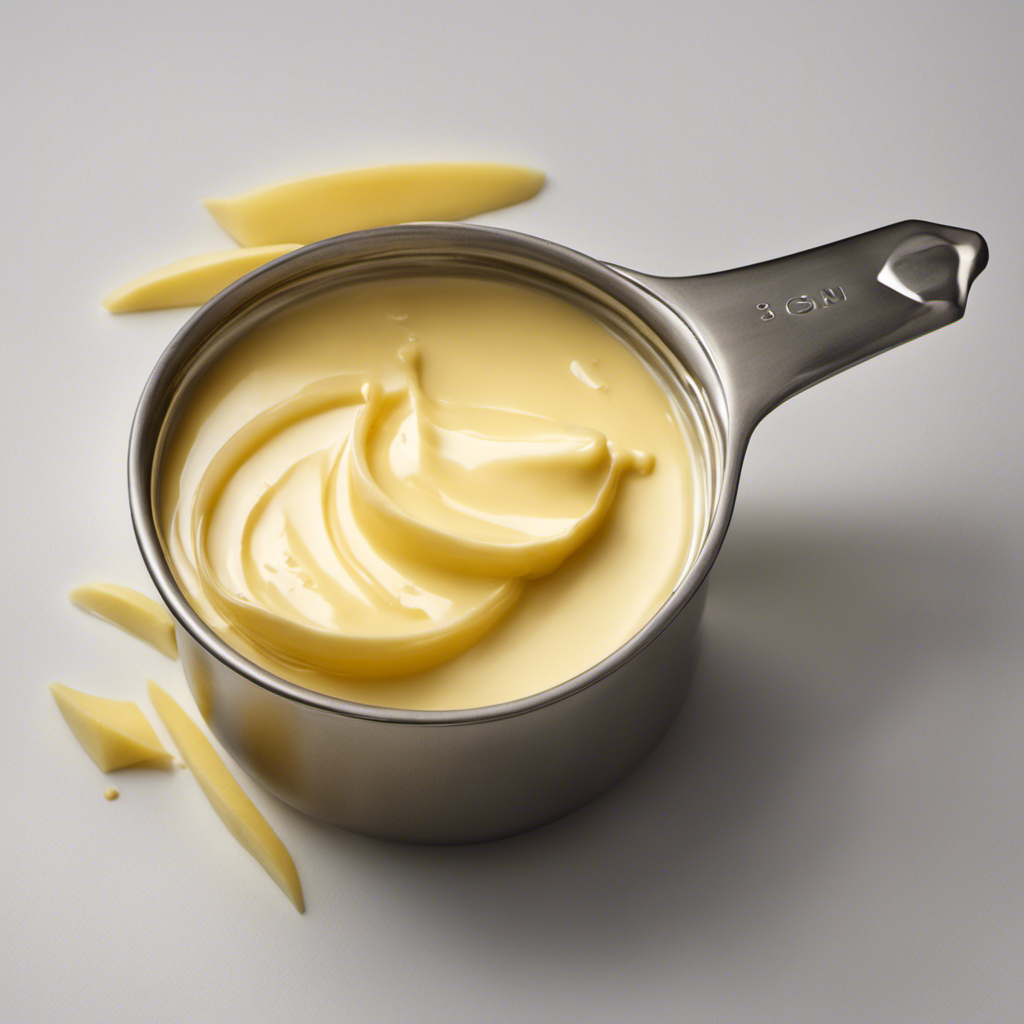
 Butter Tips and Tricks2 months ago
Butter Tips and Tricks2 months agoHow Many Tablespoons in 2/3 Cup of Butter?
-
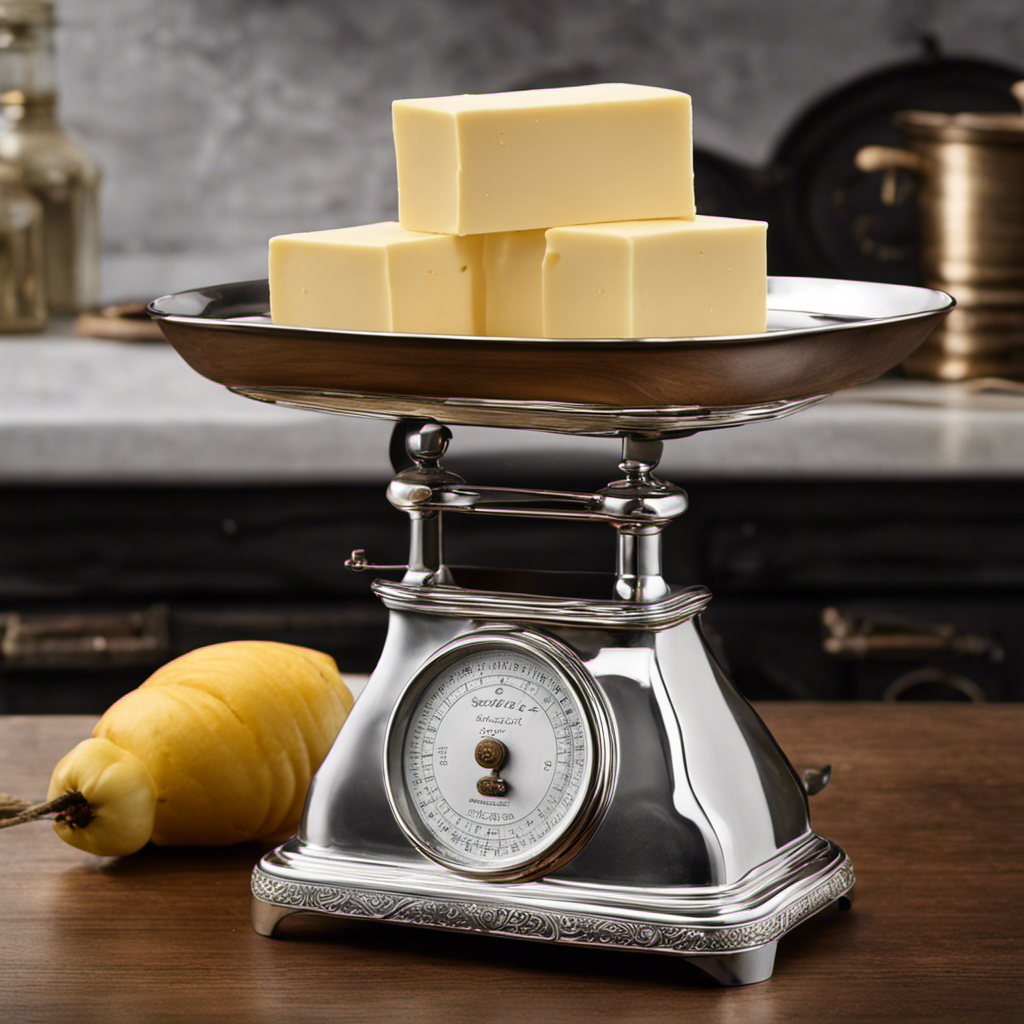
 Butter Tips and Tricks2 months ago
Butter Tips and Tricks2 months agoConverting 3/4 Cup of Butter to Sticks: How Many Sticks?
-
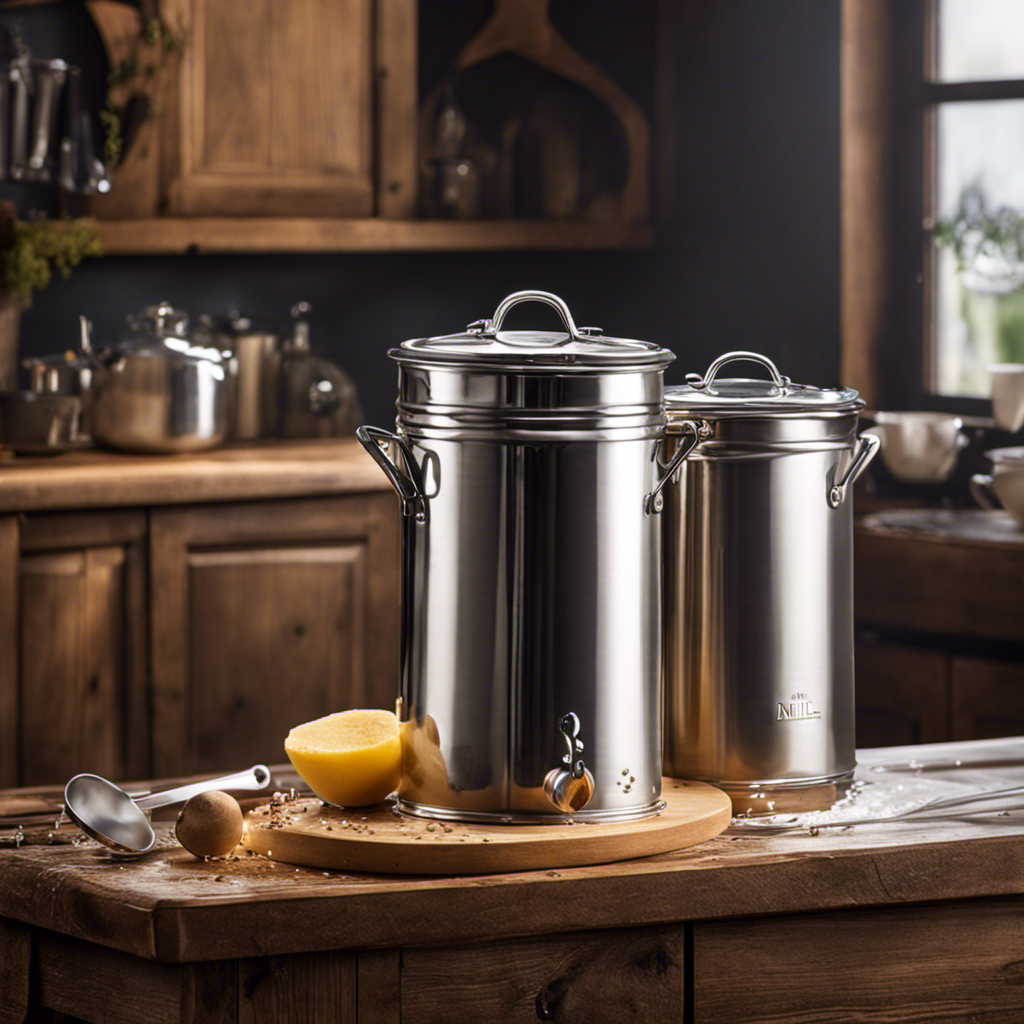
 Recipes & Culinary Uses4 months ago
Recipes & Culinary Uses4 months agoHomemade Butter Making at Home with Fresh Milk
-
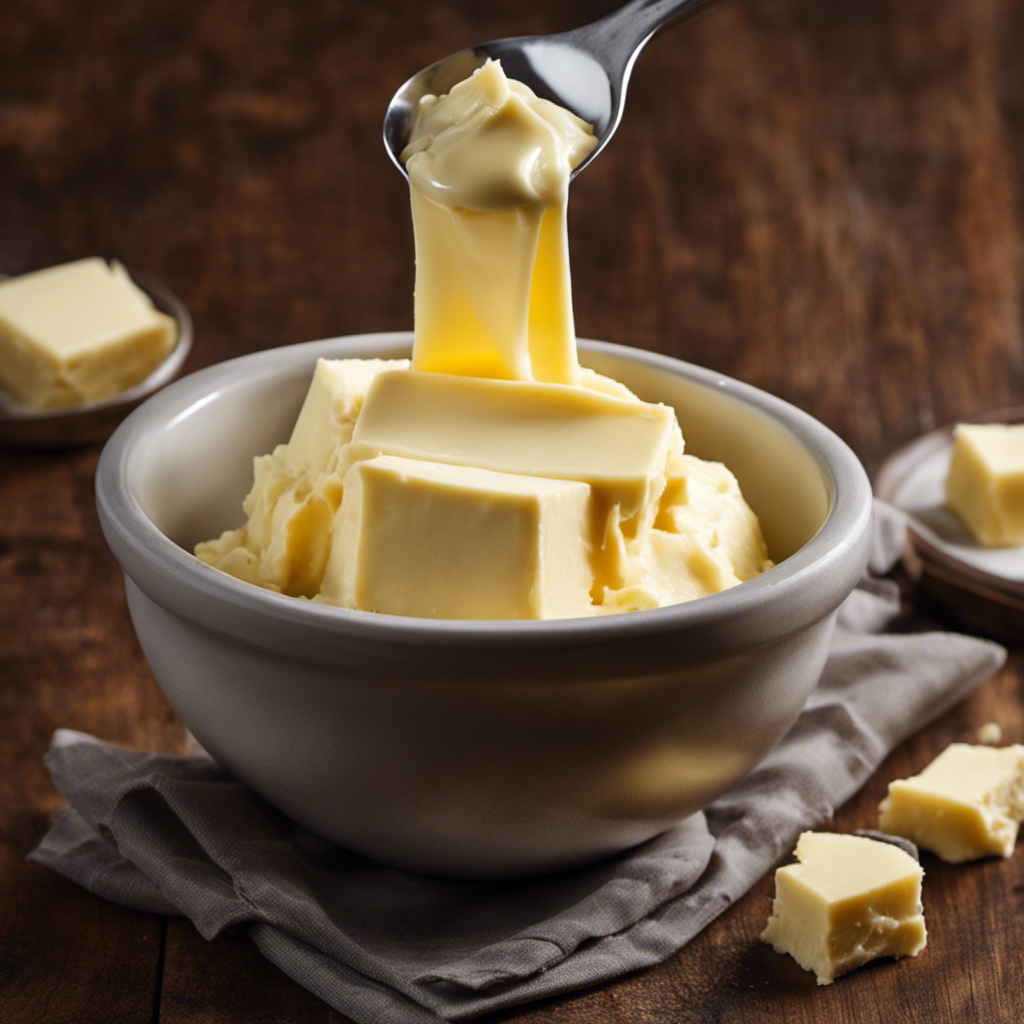
 Butter Tips and Tricks1 month ago
Butter Tips and Tricks1 month agoHow Many Tablespoons of Butter Are in 3/4 Cup?
-

 Recipes & Culinary Uses5 days ago
Recipes & Culinary Uses5 days ago10 Steps to Cook Delicious Dried Butter Beans
-
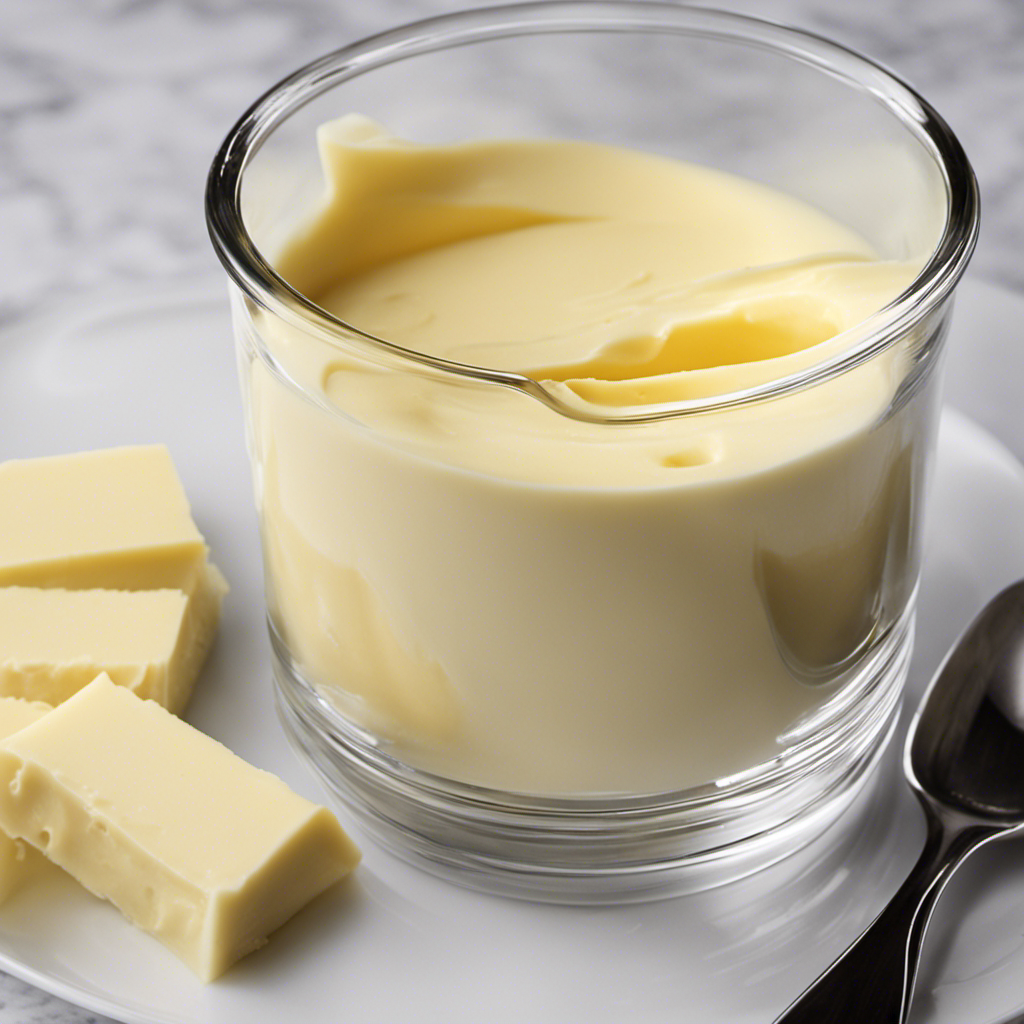
 Recipes & Culinary Uses2 weeks ago
Recipes & Culinary Uses2 weeks agoHow Many Tablespoons of Butter in 3/4 Cup: A Simple Guide
-

 Butter Tips and Tricks1 month ago
Butter Tips and Tricks1 month agoHow Many Tablespoons of Butter in 1/4 Cup: A Simple Guide
-
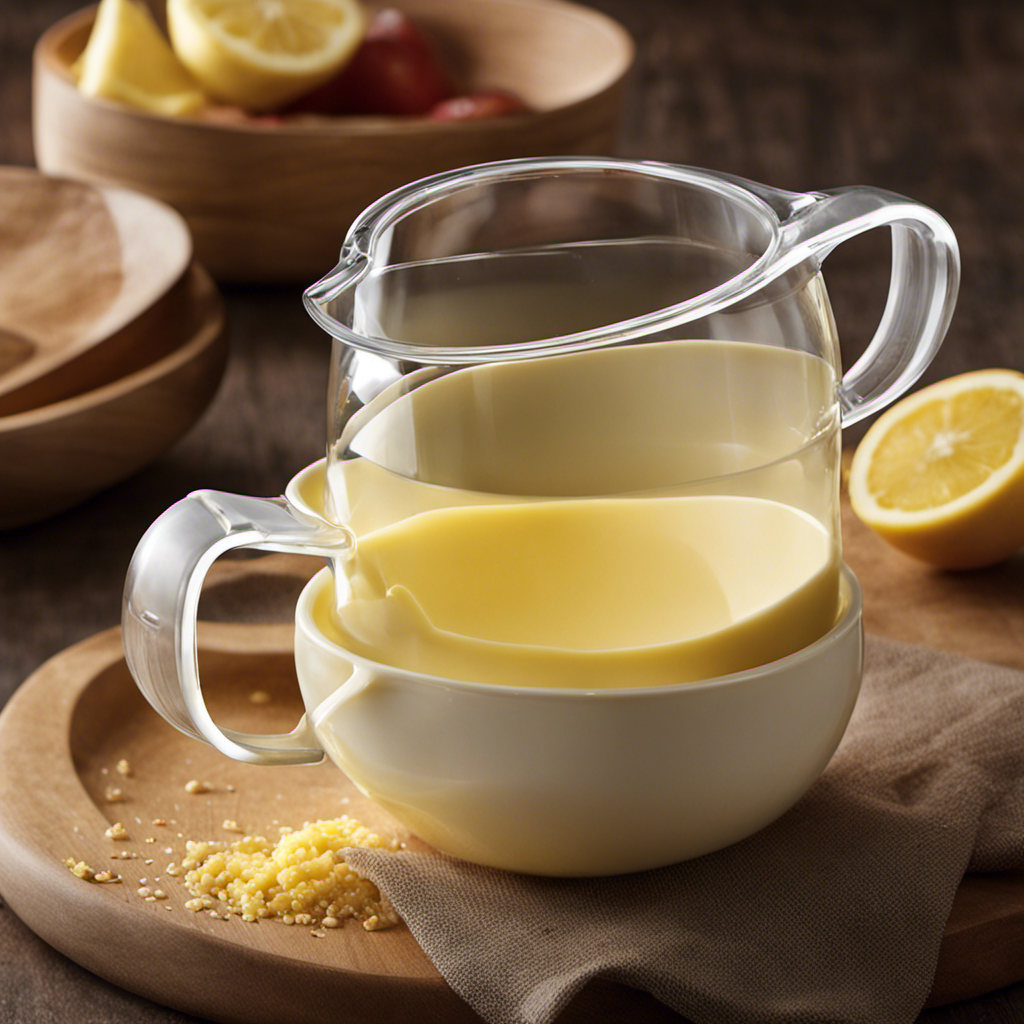
 Butter Tips and Tricks1 month ago
Butter Tips and Tricks1 month agoHow Many Tablespoons of Butter in 1/3 Cup: A Simple Guide






